

7 Popular Sailboats with Two Masts (With Pictures & Prices)
Sailboats can come with one, two, or even more masts. You can also have different-sized masts placed on the front, back, or middle of your vessel.
Below, I have listed popular sailboats that have two masts.
Let’s get started!
Table of Contents
Check also: Average sailboat price examples .
Things to Know About Sailboats With Two Masts
When looking for sailboats with two masts, you should know what you are looking for. A Ketch is one type of sailboat with two masts.
Knowing this term can help you to nail down your search when looking for a boat with two masts.
These boats come in many shapes and sizes as well as many different types of designs. Generally, these types of boats have the taller mast being forward and the smaller mast near the aft.
Yawls are also boats that feature two masts.
These also come in multiple types and designs. The difference between the Ketch and the Yawl is that the Yawl has the larger mast in the aft instead of forward. They also have smaller sails and can be easier to handle.
Another type of sailing ship that features two masts is a Brigantine.
This ship has mixed sailing rigs which commonly features squared sails on the front part of the ship and triangular sails on the back of the ship.
These boats are often larger and require more people to handle them.
7 Great Used Boats with Two Masts
There are many benefits to used boats including a lower cost. You can get a larger boat for a lower cost if you choose to buy used.
When looking at used boats, you need to make sure you look at the boat and its features thoroughly to make sure everything is in great working order.
If you do not feel confident that you can properly look over a used vessel, you can even hire a marine inspector to look it over and let you know of any potential issues or needed repairs. You can use this assessment to decide what is worth it, or if the needed repairs fall into the budget.
It is much more common for a used boat to have more than one mast. This is because the newer sailboat models are creating their new designs with just one mast.
One mast ships are easier to handle and manage so new designs are trying to optimize design and ease of sailing.
Below are great used sailboats with two masts which I have arranged by price .
1. 1976 Westerly Center Cockpit Ketch

This 1976 Westerly Center Cockpit Ketch is a small 36-foot long sailboat with two masts. This is a solidly built cruising vessel that features a center cockpit ketch layout.
This boat has a small 38 horsepower engine perfectly fit to navigate its smaller size.
The interior features 1 single berth and 3 double berths all in 3 cabins. This boat also has 2 full heads onboard.
You also have a full galley with a 4 burner stove, refrigerator and freezer, stainless steel sink, and microwave oven.
This boat makes great use of limited space and offers many amenities in a much smaller frame.
Price: $37,000.00
2. 1978 Jeanneau Gin Fizz

The 1978 Jeanneau Gin Fizz is a trusted and popular two-masted design capable of crossing the Atlantic Ocean .
This boat is also very spacious for a boat that is only 38 feet in length. This model also won an award for “security, comfort, ease of handling, and ability to handle varying conditions.”
This particular used model has been well maintained and upgraded over the years.
This boat is great for family cruising, offshore passages, and even racing.
This boat features a 50 horsepower engine to help navigation.
Inside you can find 2 cabins and 1 head. You will be highly comfortable with air conditioning and other interior luxuries.
Price: $46,000.00
3. 1979 Freedom 40
The Freedom 40 is a classically designed centerboard ketch with two masts. This boat is a great sailor loaded for cruising on the wide-open blue water.
This sailboat is 40 feet in length and features accommodations for six people that include a double-v berth, another double berth, and two single berths.
There is also a full head that can be accessed both from the main salon and aft cabin.
This boat was recently painted and features newer interior fabrics, forced air heating, and much more.
You can find a dinette with separate freezer and refrigeration compartments, a stove with an oven and broiler, a double stainless steel sink, plenty of storage, and other interior features.
This boat also comes with an outboard motor with 50 horsepower and a hard bottom inflatable dinghy.
Price: $54,900.00
4. 1977 Puma 38 Ketch

The Puma 38 Ketch is a two-masted sailboat built for racing like the rest of the Puma sailing line. This brand prides itself on speed and maneuverability.
The 1977 Puma 38 is 34 feet in length with a backup diesel engine that can help you get where you need to go as well as docking into a slip. This motor features more horsepower than the average sailboat with 45 horsepower.
Features on this vessel include autopilot, electrical and manual bilge pumps, a full marine head, running hot water, and refrigerator.
This boat is made of fiberglass with teak finishes and looks well kept. You can find this boat in Spain if you are interested in purchasing it.
Price: $66,099.00
5. 1973 Morgan Out Island 41
Originally designed by Charley Morgan, the Morgan Out Island 41 is a center cockpit shoal-draft cruiser that features two masts.
This larger boat is 41 feet 3 inches in length and features many amenities.
This boat is the tri-cabin version and features interior heating, pressurized hot and cold water, a 2 burner gas oven, and a fridge.
This boat also seats up to 7 in the 3 cabins and the saloon. There are also 2 full heads on this vessel.
This boat is even equipped with an inboard motor . Inboard motors are easier when it comes to navigation including backing up, which is generally hard for sailboats to do.
Price: $68,596.00
6. 1970 Hinckley Bermuda 40

This 1970 Hinckley Bermuda 40 is a gorgeous two-masted boat painted with a mixture of desert sand and oyster white on the exterior and features a beautiful and well-kept deck.
This boat has previously had all her systems replaced and upgraded and features a 40 horsepower engine that was new in 2014.
This boat features a mahogany interior and sleeps up to 6 people in 2 cabins. You can also find a 3 burner propane stove with oven, fridge and compressor, new countertops and plenty of storage.
This boat is a stunning and highly upgraded “must-see” at a very reasonable price.
Price: $129,500.00
7. 1995 Amel Super Maramu

A newer model of sailboat is the 1995 Amel Super Maramu sailboat. This sailboat has two masts and is very long at 53 feet.
This boat features an aft deck, steps molded right into the hull, well-protected cockpit an many other features. This boat has a large 76 horsepower engine which is more than the average sailboat is equipped with.
Inside, this boat features 2 cabins and 2 heads with showers. There is also plenty of storage, air conditioning , and electric heaters. There is also a nice salon and galley with a refrigerator, dishwasher, chest freezer, microwave oven, 3 burner stove, and other appliances.
This boat is great for multiple days out on the water and is new and updated. Because of the year, this was manufactured and the features, this boat has a larger price tag than the previous models.
Price: $299,990.00
Final Thoughts:
Sailboats are a great way to enjoy a day out at sea. Most sailboat models come with sleeping arrangements and even a kitchen. This makes them ideal for trips that will take more than a day.
Having multiple masts allows you to harness the power of the wind better and can increase your speed and directional capabilities.
There are many great choices when it comes to boats with two masts, but newer models are starting to steer away from double mast designs. This does not mean that you cannot get a good boat with two masts.
Used boats can be great choices when it comes to purchasing a boat. This is even more true with large, yacht boats such as the ones listed above.
Just make sure when you buy a used sailboat you check that everything is intact and in good working order and if it is not, you have allotted space in the budget to fix what is needed.
Your new double-masted sailboat should provide you with plenty of long-lasting memories and adventures out on the water while you connect with the wind and the sea.
Click to share...

What’s a Boat with Two Masts Called: Two masted sailing boat types
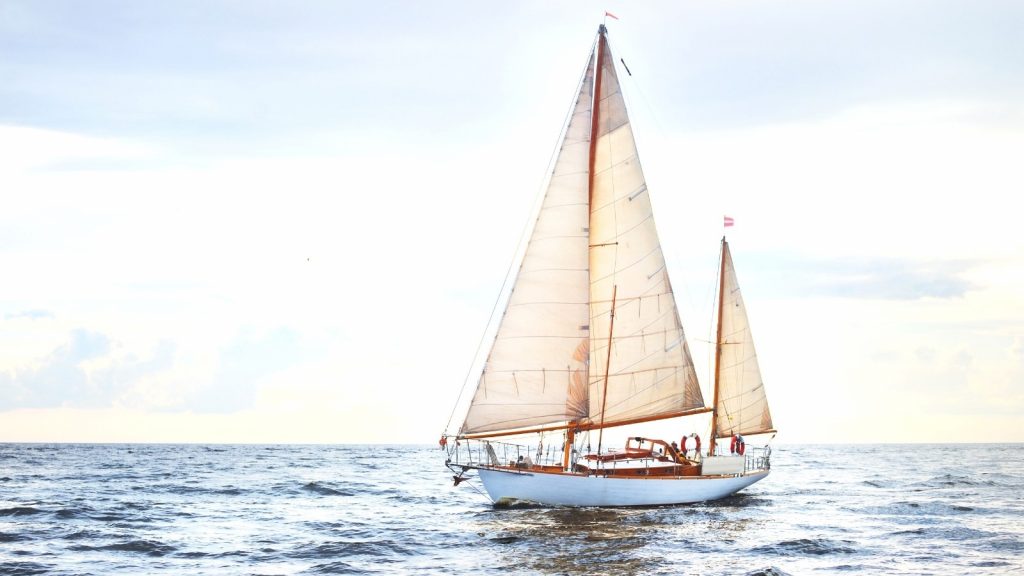
Two-masted sailing boats will always have a special place in the hearts of many sailors. Many sailors consider two-masted sailing boats to be the most attractive and graceful of all sailing vessels. They have an obvious elegance, but what do you know about these two masted sailboats? Let’s find out!
Among the most important aspects are the fact that two-masted sailing boats offer greater sail balance, engineless sailing and more heavy weather options.
Even if the two masted sailboats are not so common, the sailing world has a few of them and what is more, they represent a proof of the evolution and improvement of sailing boats over time. There are an almost endless number of ways sailors have arranged their sails on boats over the years.

Two-masted sailing boats are classified according to the size and position of their masts.
There are different two-masted sailing boat types and two of the most popular are schooners and yawls.
The origins of schooner-rigged vessels are unknown, however there is evidence of them in paintings by Dutch maritime painters dating back to the early 17th century.
Schooners were developed by Northern European countries, while yawls are believed to be descended from the fishing boats of England.
Sailboats with two masts include yawls, ketches, schooners and brigs (known as brigantines). Yawls and ketches are both types of sloops, which means they have one mast, but the difference between them is that the yawl has a second mast stepped at the bow.
Ketches and Yawls have a lower mast, unlike schooners that have a taller aft mast, which is also known as mizzen. Ketch sailing boats have something specific: the aft mast is located in front of the rudder post.
The yawl’s mizzenmast serves as a counterbalance for the jib sails, so that it doesn’t have to be hung from the forestay (the rope running from the top of the mast down to the deck). They’re usually smaller than ketches and have less rigging because they don’t carry as many sails as a sloop with two masts.
Yawls are faster sailboats than schooners because they’re lighter, more balanced and easier to sail upwind. They can also go faster because their shorter sails catch more wind. But schooners have larger payloads, which means more people or cargo — an important consideration for long trips without resupply.

Schooners are two-masted sailing boats, but instead of having a jib sail like yawls, ketches and most sloops, schooners have a fore-and-aft spanker sail like a gaff sailboat. These two-masted sailboats have at least two masts, the foremast being slightly shorter than the main mast.
Schooners are larger than yawls, ketches and other sloops and weren’t used very much in modern times because they were more difficult to handle. They’re still used in racing competitions today.
Schooners have a longer bow portion than yawls. The mainsail is aft of the mast, and either one or two foresails are in front of it. In a schooner, these are triangular sails; in a yawl, they’re trapezoidal. Yawls have bowsprits — poles that extend beyond the bow for the jib and stay sail to be attached. Schooners have small bowsprits that can support jibs but not large sails.

The term ketch derives from the word catch, which hints to how it got its name in the 17th century. Ketches were initially intended to meet the specific requirements of offshore net fishing.
Ketch is a type of sailboat that features two masts and two sails, commonly used as a racing and cruising boat. The mainmast of this two-masted sailboat is typically taller than the mizzen mast (aft-mast). Its name derives from catch.
Taller masts allow you to use larger sails, so ketch boats are able to achieve better speeds than similar boats with only one mast. Some ketch designs feature a gaff rig, which is similar to a yawl, while others feature a yawl rig, which looks like a traditional sloop.
Ketch boats may look easy to sail but the slightest mistake can lead to disaster. You must be careful when operating this type of boat because it does not have as much stability as other boats, especially when you’re manoeuvring in tight quarters or windy conditions.
A ketch may also be a small recreational boat with only one head-sail in use. Many modern designs have moved away from sail altogether and are powered by engine, while others use both sails as well as engines depending on circumstance.

The brigantine was once a tiny ship that carried both oars and sails. It was a favorite of Mediterranean pirates.
A brigantine is a square-rigged sailing boat with two masts, with a fully square-rigged foremast and two sails on the mainmast.
The mainmast is stepped forward of the deck, making it possible to sail into the wind using a triangular headsail known as a jib. The brig’s foremast is shorter than the mainmast.
The name of this type of boat with 2 masts is derived from the Italian word “brigantino”, which means brigand.
Also, this two-masted sailing boat type was most commonly used for coastal trade and pirate hunting. The brigantine had an advantage over other ships of the time because it could sail against the wind using both sails, making it easier to travel against strong winds.
Faster and easier to manoeuvre than a sloop or schooner, it was used for piracy and espionage.

FAQ: Two-Masted Sailboats
What do you call a two-masted sailboat.
Two-masted sailboats are of several types: yawls, schooners, ketches or brigantines.
Why do some sailboats have two masts?
The vast majority of sailboats feature a mainsail and a jib. These two-masted sailboats provide several advantages in terms of speed and maneuverability. These two masts may be configured in a variety of ways.
The foresail directs air beyond the back of the mainsail, generating greater power from the wind. In order to help menouvering, the foresail can be backed. So, adding sails makes things simpler for bigger boats, making them easier to handle in heavy winds.
What is the difference between a ketch and a yawl sailboat?
Because they are lighter, more balanced, and easier to sail upwind, yawls are faster sailboats than schooners. They can also go at a faster speed since their shorter sails collect more wind. Schooners, on the other hand, have higher cargoes, which means more people or freight – a crucial consideration for extended journeys without replenishing.
What is a one masted sailboat?
It's a sailing boat having a single mast roughly one-third the length's aft of the bow. A sailboat with a single mast usually has one headsail in front of the mast and one mainsail behind the mast.
What is a two-masted square rigger?
It's a brig with two square-rigged masts. A gaff-rigged fore-and-aft sail also called a "mizzen" is used in addition to jibs and staysails (stays'ls) before the foremast and staysails between the masts.
Leave a Comment Cancel Reply
Your email address will not be published. Required fields are marked *
- The Enchanting World of Two-Masted Sailing Ships: A Comprehensive Guide
Two-masted sailboats, with their elegant profiles slicing through the waves, serve as a bridge between the past and present, combining traditional sailing heritage with contemporary performance. These vessels, marked by their dual masts—the foremast and the mainmast—embody a blend of artistry and engineering, appealing to a wide array of sailing enthusiasts.
History and Evolution: From Ancient Origins to Technological Advancements
The lineage of two-masted sailboats stretches back to ancient maritime civilizations, where the imperative of ocean exploration spurred the development of advanced sailing technologies. These early innovations laid the groundwork for the evolution of sailboats, which adapted over the centuries to meet the changing demands of navigation, trade, and warfare. The design and functionality of two-masted sailboats have been refined through technological advancements, making them as much a symbol of historical progress as they are of nautical tradition.
Design and Features: Anatomy and Types of Two-Masted Sailboats
Understanding the design of a two-masted sailboat is key to appreciating its capabilities. The complex arrangement of hull, masts, sails, rigging, and keel is essential for the boat's performance at sea. These components work in harmony to harness the power of the wind, enabling the vessel to navigate with precision and grace. The variety within this category, including schooners, ketches, yawls, and brigs, highlights the adaptability of two-masted sailboats to different sailing needs, from leisurely coastal cruising to high-stakes ocean racing.
Read our top notch articles on topics such as sailing, sailing tips and destinations in our Magazine .
Check out our latest sailing content:
How to gear up for the 2024 sailing season
Where and why to sail from Lefkas marina
Don’t panic: handling maritime emergencies
The best sailing routes from Biograd na Moru
Yachting Away from Ourselves: A Voyage to Inner Peace
Sail to the 7 most beautiful sights in Greece
What skipper's licence do I need?
From Lefkada or Corfu to Paxos and Antipaxos
Discover the paradise of Paxos and Antipaxoss
Discover Corfu: sailing adventure in the Ionian
Sextant and navigation: survival without GPS
5 best sailing routes in the Bahamas
Yachting guide to the Bahamas
The ultimate yacht cleaning kit
Introduction to chartering with a skipper
Traditional sailor tattoos: Meaning of the swallow
The most popular catamarans of 2023
Fishing and sailing: where to sail for the best catches?
Lighthouses you won't forget
New Year's resolution: let's sail more eco
British Virgin Islands: sailing paradise
How to get kids to enjoy sailing?
How to sail a yacht on a tailwind
How to sail a yacht in crosswinds
Götheborg: the greatest sailing ship
How to have a nautical Christmas
What to pack for a tropical sailing
How to sail a yacht against the wind
Sailing the Maldives: paradise
Interview: is ocean pollution irreversible?
Two-Masted Sailboats in Use Today: Recreational and Competitive Sailing
Today, two-masted sailboats flourish in both recreational and competitive arenas. For leisure sailors, these vessels offer a unique combination of challenge and tranquility, allowing for intimate experiences with the sea. The versatility of two-masted sailboats makes them ideal for a range of activities, from day sailing to extended voyages. In the competitive realm, these sailboats demonstrate their enduring relevance and performance, participating in regattas and races that test the skill and strategy of their crews.
Maintenance and Upkeep: Ensuring Longevity and Performance
The beauty and functionality of two-masted sailboats are preserved through meticulous maintenance and thoughtful care. Routine inspections and maintenance tasks are crucial for keeping these vessels seaworthy, highlighting the importance of attention to detail in preserving their condition. Beyond the immediate upkeep, long-term care strategies are essential for ensuring that these iconic vessels continue to grace the world's waterways, serving as living links to the rich maritime heritage they embody.
Famous Two-Masted Ships: Icons of the Seas
Throughout history, several two-masted ships have etched their names into the annals of nautical lore, becoming icons of exploration, power, and adventure. Ships like the HMS Beagle, renowned for carrying Charles Darwin on his epic voyage that contributed to the development of evolutionary theory, and the schooner Bluenose, a racing legend and fishing vessel that symbolized Canadian grit and maritime prowess, are prime examples. These famous ships not only highlight the critical role of two-masted vessels in exploration and competition but also celebrate their timeless beauty and enduring spirit.
In essence, two-masted sailboats encapsulate the spirit of sailing, merging the allure of history with the thrill of modern-day navigation. They stand as a testament to human creativity and the ceaseless quest for harmony with the elements, inviting each new generation of sailors to partake in a journey that transcends time and tides.
So what are you waiting for? Take a look at our range of charter boats and head to some of our favourite sailing destinations.
Interested in exploring the world of two-masted sailing ships? Contact me to book your yacht experience today!

Denisa Nguyenová
Understanding the Two-Masted Sailboat
By Matt Claiborne
Two-Masted Boats with Fore-and-Aft Rigged Sails
A ketch is a two-masted sailboat. The rear mast, called the mizzen mast, is shorter than the forward main mast. The mizzen mast is mounted forward of the rudder post.
A yawl is similar to a ketch, but the rear mizzen mast is moved farther aft, behind the rudder post. This makes the mizzen on a yawl seem like an afterthought, almost like it’s attached to the railing.
If a two mast boat has masts of equal height or the forward mast is the shorter of the two, it is a schooner. They can have as many masts as the design called for.
Benefits of Two Masted Sailboats
Easy to balance steering forces
More sail plan options for heavy winds
Lower sheet loads mean smaller and less expensive
Lighter loads on smaller sails for easier handling
Shorter overall mast height for bridge clearance
Mizzen can be used as a riding sail at anchor
2 Masted Ship Examples with Square Rigged Sails
A brig is a double mast sailboat with both masts square rigged. In addition, it has fore-and-aft staysails and jibs and a mizzen sail on the aft mast–which is usually gaff-rigged.
A brigantine is a ship with two masts, with the foremast square-rigged and the aft mainmast fore-and-aft rigged.
The Two-Masted Sailboat
Boat maintenance.

What Is a Ketch Sailboat?

Last Updated by
Daniel Wade
August 30, 2022
Ketch sailboats are a common sight in some areas, and they have numerous handling benefits. But what is a ketch, and how does it differ?
A ketch is a two-mast sailboat similar to a yawl. The mainmast is shorter than a sloop, and the mizzenmast aft is shorter than the mainmast. A ketch usually has a triangular mizzen sail and a triangular or square headsail.
In this article, we’ll cover the general characteristics of a ketch and how to distinguish it from other two-masted sailboats. Additionally, we’ll go over the benefits of the ketch rig and how it compares to the similar yawl rig. We’ll also overview the most common types of ketch sailboats on the water today.
We sourced the information used in this article from sailboat identification guides and rig design diagrams.
Table of contents
General Description of a Ketch Sailboat
A ketch is a two-masted sailboat with a tall mizzenmast mast aft of the mainmast. A key characteristic of Ketch sailboats is that their mizzenmast is shorter than the mainmast.
The mainmast itself is typical and resembles a sloop mast. A ketch has a mainsail and one or more headsails on the mainmast, along with a single mizzen on the mizzenmast.
A ketch can easily be mistaken for a yawl, as these vessels have similar sail arrangements. Ketch sailboats can have square or triangular rigs, depending on the age and specific design of the boat.
A gaff headsail is usually accompanied by a triangular mizzen on a ketch, similar to a schooner.
Ketch Sailboat History
The ketch is a relatively old part of the sailing world. Based on the classic yawl design, the ketch was used extensively for workboats on the New England coast at the height of the sailing era.
Ketch sailboats were robust and easy to handle. They also tracked a naturally straight course due to their mizzen, which was used as a primitive form of self-steering. This was helpful for small fishing boats, as the crew didn’t need to attend to the rudder quite so often.
Ketch sailboats continued working the New England coast well into the era of steam. In the mid to late-1800s, ketch-rigged workboats were still a common sight in coastal areas.
Today, they persist as recreational and cruising sailboats, as their tough and stable rigs are still a practical option for boatbuilders.
Types of Ketch Sailboats
There are many types of ketch sailboats on the water. The ketch is not the most common kind of sailboat, but there are enough of them around to notice once in a while. Ketch sailboats were once utility boats, but they’ve been strictly used for recreational and cruising boats for the last 100 years or so.
The most common kind of ketch is the simple cruising ketch. These sailboats are typically made of fiberglass and resemble other cruising sailboats in almost every way.
Their interior accommodations are the same as a comparably-sized sloop, though cockpit space is limited due to the presence of a mizzenmast and rigging.
The ketch rig is a popular choice for motorsailers, especially heavy-displacement versions. The ketch is a stable design with quite a bit of power due to its additional mast, which allows the mainsail and boom footprint to be slightly smaller. The ketch is also highly controllable, which is great for closed-cockpit sailboats.
The ketch rig is also popular on classic sailboats. Specifically, the gaff-rigged ketch is a common sight in some classic boat circles—particularly on the East Coast of the United States. Wooden ketch-rigged boats were outfitted with both traditional square and modern triangular rigs.
There are a few smaller open-cockpit ketch sailboats around, and these are popular for cruising deeper water—but not far from shore. Open cruising ketch sailboats are usually less than 20 feet long and can be found most often around Chesapeake Bay.
Cutter Ketch Rig
A cutter ketch is simply a ketch rig with additional headsails. Because the mast is in the same position as a sloop, the ketch is easy to rig with additional forward sails. A typical cruising ketch can use a wide variety of headsails, including a spinnaker.
Ketch Vs Yawl
The ketch rig is very similar to the yawl, which also has a tall mainmast and an additional mizzenmast and mizzen aft. The yawl is a much older boat that originated in England or Scotland around the 17th century.
The yawl rig usually has a shorter mizzenmast that’s positioned further aft, as the mizzen boom usually extends beyond the stern of the boat. A ketch mizzen is positioned forward, usually a bit larger and more comparable to the size of the mainsail.
Yawl and ketch rigs are both quite stable. A ketch usually has a bit more power due to its larger mizzen, though the yawl is generally considered to be easier for a single person or a short-handed crew to handle.
Ketch Rig Benefits
There are numerous benefits to the ketch rig, especially when compared to tall Marconi/Bermuda rigs. The primary benefit is that, despite the additional mast and rigging, a ketch is exceptionally easy to handle.
A ketch spreads out its sail area between the headsail, mainsail, and mizzen. The additional mast and sail allow the mainmast to be shortened, which naturally makes the boat easier to control single-handed.
Ketch rigs offer additional precision, as you can adjust three sails independently to optimize performance for any given wind condition. The mizzen is in close proximity to the cockpit, and due to its small size, it’s easy to control.
Ketch rigs can also self-steer to some extent. The mizzen works the same way that a stabilizing sail on a fishing drift boat does and keeps the boat tracking on a straight course with or without constant rudder input from the crew.
The ketch rig also offers a level of redundancy that traditional single-masted sailboats don’t have. This is particularly attractive to long-range cruisers. A ketch has a shorter mainmast, which allows boatbuilders to use stronger materials and maintain the same weight.
A ketch can continue sailing if you lose a mainstay or suffer dismasting, as there’s an additional mast aft that probably won’t also go down. This extra level of safety is useful when conditions are rough, and it also gives you peace of mind when out on the open ocean.
Related Articles
I've personally had thousands of questions about sailing and sailboats over the years. As I learn and experience sailing, and the community, I share the answers that work and make sense to me, here on Life of Sailing.
by this author
Learn About Sailboats
Most Recent

What Does "Sailing By The Lee" Mean?
October 3, 2023

The Best Sailing Schools And Programs: Reviews & Ratings
September 26, 2023
Important Legal Info
Lifeofsailing.com is a participant in the Amazon Services LLC Associates Program, an affiliate advertising program designed to provide a means for sites to earn advertising fees by advertising and linking to Amazon. This site also participates in other affiliate programs and is compensated for referring traffic and business to these companies.
Similar Posts

Affordable Sailboats You Can Build at Home
September 13, 2023

Best Small Sailboat Ornaments
September 12, 2023

Discover the Magic of Hydrofoil Sailboats
December 11, 2023
Popular Posts

Best Liveaboard Catamaran Sailboats
December 28, 2023

Can a Novice Sail Around the World?
Elizabeth O'Malley
June 15, 2022

4 Best Electric Outboard Motors

How Long Did It Take The Vikings To Sail To England?

10 Best Sailboat Brands (And Why)
December 20, 2023

7 Best Places To Liveaboard A Sailboat
Get the best sailing content.
Top Rated Posts
Lifeofsailing.com is a participant in the Amazon Services LLC Associates Program, an affiliate advertising program designed to provide a means for sites to earn advertising fees by advertising and linking to Amazon. This site also participates in other affiliate programs and is compensated for referring traffic and business to these companies. (866) 342-SAIL
© 2024 Life of Sailing Email: [email protected] Address: 11816 Inwood Rd #3024 Dallas, TX 75244 Disclaimer Privacy Policy
17 Sailboat Types Explained: How To Recognize Them
Ever wondered what type of sailboat you're looking at? Identifying sailboats isn't hard, you just have to know what to look for. In this article, I'll help you.
Every time I'm around a large number of sailboats, I look around in awe (especially with the bigger ones). I recognize some, but with most of them, I'll have to ask the owner. When they answer, I try to hide my ignorance. The words don't make any sense!
So here's a complete list with pictures of the most common sailboat types today. For each of them, I'll explain exactly where the name comes from, and how you can recognize it easily.

So here's my list of popular sailboat types, explained:
Bermuda sloop, sailing hydrofoil, dutch barge, chinese junk, square-rigged tall ship, in conclusion, how to recognize any sailboat.
Before we get started, I wanted to quickly explain what you should look for when you try to identify a sailboat.

The type of sailboat is always determined by one of these four things:
- The type of hull
- The type of keel
- The number of masts
- And the type of sails and rig
The hull is the boat's body. There are basically three hull types: monohull, catamaran, and trimaran. Simply said: do I see one hull, two hulls (catamaran) or three hulls (trimaran)? Most sailboats are monohulls.
Next, there is the keel type. The keel is the underwater part of the hull. Mostly, you won't be able to see that, because it's underwater. So we'll leave that for now.
The sail plan
The last factor is the number of masts and the sail plan. The sail plan, simply put, is the number of sails, the type of sails, and how the sails are mounted to the masts (also called rigging ).
Sailboat are mostly named after the sail plan, but occasionally, a sail type is thrown in there as well.
So now we know what to pay attention to, let's go and check out some sailboats!

Dinghies are the smallest and most simple sailboats around.
They are your typical training sailboats. Small boats with an open hull, with just one mast and one sail. Perfect for learning the ways of the wind.
On average, they are between 6 and 20 ft long. Mostly sailed single-handed (solo). There's no special rigging, just the mainsail. The mainsail is commonly a Bermuda (triangular) mainsail. Dinghies have a simple rudder stick and no special equipment or rigging.
Dinghies are great for learning how to sail. The smaller the boat, the better you feel the impact of your trim and actions.
How to recognize a sailing dinghy:
- short (8ft)
- one Bermuda sail
- open hull design
- rudder stick
Common places to spot them: lakes, near docks

If you'd ask a kid to draw a sailboat, she'll most probably draw this one. The Bermuda Sloop is the most popular and most common sailboat type today. You'll definitely recognize this one.
How to recognize a Bermuda Sloop:
- triangular mainsail (called a Bermuda sail)
- a foresail (also called the jib)
- fore-and-aft rigged
- medium-sized (12 - 50 ft)
Fore-and-aft rigged just means "from front to back". This type of rigging helps to sail upwind.
Any sailboat with one mast and two sails could still be a sloop. Even if the sails are another shape or rigged in another way. For example, here's a gaff-rigged sloop (more on the gaff rig later):

If you want to learn all about sail rigs, check out my full Guide to Understanding Sail Rig Types here. It has good infographics and explains it in more detail
The Bermuda sloop has a lot of advantages over other sailboat types (which is why it's so popular):
- the Bermuda rig is very maneuverable and pretty fast in almost all conditions
- it's really versatile
- you can sail it by yourself without any problems
- it's a simple setup
Common places to spot a sloop: everywhere. Smaller sloops are more common for inland waters, rivers, and lakes. Medium-sized and large sloops are very popular cruising boats.

Cutters have one mast but three or more sails. Most cutters are Bermuda rigged, which means they look a lot like sloops.
How to recognize a cutter:
- looks like a sloop
- two or more headsails instead of one
- commonly one mast
- sometimes an extra mast with mainsail
Cutters have more sail area, which makes them faster, but also harder to sail single-handed. There's also more strain on the mast and rigging.
Common places to spot a cutter: everywhere. Cutters are very popular for cruising.
They mostly have a Bermuda rig, which means triangular sails. But there are also gaff cutters and naval cutters, and some have two masts.
Here's an example of a two-masted naval cutter with an extra gaff mainsail and top gaff:

The Hydrofoil is a pretty new sailboat design. It's a racing sailboat with thin wing foils under the hull. These lift up the hull, out of the water, reducing the displacement to nearly zero. The foils create downforce and keep it from lifting off entirely.
This makes the hydrofoil extremely fast and also impressive.
The hydrofoil refers to the keel type. There are both monohull and multihull hydrofoils.
How to recognize a hydrofoil:
- it flies above the waterline and has small fins
Common places to spot a hydrofoil: at racing events

Famous catamaran: La Vagabonde from Sailing La Vagabonde
A catamaran is a type of cruising and racing multihull sailboat with two hulls. The hulls are always the same size.
Most catamarans have a standard Bermuda rig. The catamaran refers to the hull, so it can have any number of masts, sails, sail types and rig type.
How to recognize a catamaran:
- any boat with two hulls is called a catamaran
Common places to spot catamarans: coastal waters, The Caribbean, shallow reefs
The advantages of a catamaran: Catamarans heel less than monohulls and are more buoyant. Because of the double hull, they don't need as deep a keel to be stable. They have a smaller displacement, making them faster. They also have a very shallow draft. That's why catamarans are so popular in the Caribbean, where there's lots of shallow water.
Catamarans are nearly impossible to capsize:
"Compared with a monohull, a cruising catamaran sailboat has a high initial resistance to heeling and capsize—a fifty-footer requires four times the force to initiate a capsize than an equivalent monohull." Source: Wikipedia

How to recognize a trimaran:
- any boat with three hulls is called a trimaran
Trimarans have three hulls, so it's a multi-hull design. It's mostly a regular monohull with two smaller hulls or floaters on the sides. Some trimarans can be trailered by winching in the auxiliary hulls, like this:

This makes them very suitable for long-term cruising, but also for regular docking. This is great for crowded areas and small berths, like in the Mediterranean. It sure is more cost-effective than the catamaran (but you also don't have the extra storage and living space!).
Common places to spot Trimarans: mostly popular for long-term cruising, you'll find the trimaran in coastal areas.

Gaffer refers to gaff-rigged, which is the way the sails are rigged. A gaff rig is a rectangular sail with a top pole, or 'spar', which attaches it to the mast. This pole is called the 'gaff'. To hoist the mainsail, you hoist this top spar with a separate halyard. Most gaffers carry additional gaff topsails as well.
Gaff rigs are a bit less versatile than sloops. Because of the gaff, they can have a larger sail area. So they will perform better with downwind points of sail. Upwind, however, they handle less well.
How to recognize a gaffer:
- sail is rectangular
- mainsail has a top pole (or spar)
Since a gaffer refers to the rig type, and not the mast configuration or keel type, all sailboats with this kind of rigging can be called 'gaffers'.
Common places to spot a gaffer: Gaffers are popular inland sailboats. It's a more traditional rig, being used recreationally.

Schooners used to be extremely popular before sloops took over. Schooners are easy to sail but slower than sloops. They handle better than sloops in all comfortable (cruising) points of sail, except for upwind.
How to recognize a schooner:
- mostly two masts
- smaller mast in front
- taller mast in the back
- fore-and-aft rigged sails
- gaff-rigged mainsails (spar on top of the sail)
Common places to spot a schooner: coastal marinas, bays

How to recognize a ketch:
- medium-sized (30 ft and up)
- smaller mast in back
- taller mast in front
- both masts have a mainsail
The ketch refers to the sail plan (mast configuration and type of rig). Ketches actually handle really well. The back mast (mizzenmast) powers the hull, giving the skipper more control. Because of the extra mainsail, the ketch has shorter masts. This means less stress on masts and rigging, and less heel.
Common places to spot a ketch: larger marinas, coastal regions

How to recognize a yawl:
- main mast in front
- much smaller mast in the back
- back mast doesn't carry a mainsail
The aft mast is called a mizzenmast. Most ketches are gaff-rigged, so they have a spar at the top of the sail. They sometimes carry gaff topsails. They are harder to sail than sloops.
The yawl refers to the sail plan (mast configuration and type of rig).
Common places to spot a yawl: they are not as popular as sloops, and most yawls are vintage sailboat models. You'll find most being used as daysailers on lakes and in bays.

Dutch Barges are very traditional cargo ships for inland waters. My hometown is literally littered with a very well-known type of barge, the Skutsje. This is a Frisian design with leeboards.
Skutsjes don't have a keel but use leeboards for stability instead, which are the 'swords' or boards on the side of the hull.
How to recognize a Dutch Barge:
- most barges have one or two masts
- large, wooden masts
- leeboards (wooden wings on the side of the hull)
- mostly gaff-rigged sails (pole on top of the sail, attached to mast)
- a ducktail transom

The clipper is one of the latest sailboat designs before steam-powered vessels took over. The cutter has a large cargo area for transporting cargo. But they also needed to be fast to compete with steam vessels. It's a large, yet surprisingly fast sailboat model, and is known for its good handling.
This made them good for trade, especially transporting valuable goods like tea or spices.
How to recognize a Clipper:
- mostly three masts
- square-rigged sails
- narrow but long, steel hull
Common places to spot a clipper: inland waters, used as houseboats, but coastal waters as well. There are a lot of clippers on the Frisian Lakes and Waddenzee in The Netherlands (where I live).

This particular junk is Satu, from the Chesapeake Bay Area.
The Chinese Junk is an ancient type of sailboat. Junks were used to sail to Indonesia and India from the start of the Middle Ages onward (500 AD). The word junk supposedly comes from the Chinese word 'jung', meaning 'floating house'.
How to recognize a Chinese junk:
- medium-sized (30 - 50 ft)
- large, flat sails with full-length battens
- stern (back of the hull) opens up in a high deck
- mostly two masts (sometimes one)
- with two mainsails, sails are traditionally maroon
- lug-rigged sails
The junk has a large sail area. The full-length battens make sure the sails stay flat. It's one of the flattest sails around, which makes it good for downwind courses. This also comes at a cost: the junk doesn't sail as well upwind.

The cat rig is a sail plan with most commonly just one mast and one sail, the mainsail.
Most sailing dinghies are cats, but there are also larger boats with this type of sail plan. The picture above is a great example.
How to recognize a cat rig:
- smaller boats
- mostly one mast
- one sail per mast
- no standing rigging
Cat-rigged refers to the rigging, not the mast configuration or sail type. So you can have cats with a Bermuda sail (called a Bermuda Cat) or gaff-rigged sail (called a Gaff Cat), and so on. There are also Cat Ketches and Cat Schooners, for example. These have two masts.
The important thing to know is: cats have one sail per mast and no standing rigging .
Most typical place to spot Cats: lakes and inland waters

Famous brig: HMS Beagle (Charles Darwin's ship)
A brig was a very popular type of small warship of the U.S. navy during the 19th century. They were used in the American Revolution and other wars with the United Kingdom. They carry 10-18 guns and are relatively fast and maneuverable. They required less crew than a square-rigged ship.
How to recognize a brig:
- square-rigged foremast
- mainmast square-rigged or square-rigged and gaff-rigged

How to recognize a tall ship:
- three or four masts
- square sails with a pole across the top
- multiple square sails on each mast
- a lot of lines and rigging
Square-rigged ships, or tall ships, are what we think of when we think of pirate ships. Now, most pirate ships weren't actually tall ships, but they come from around the same period. They used to be built from wood, but more modern tall ships are nearly always steel.
Tall ships have three or four masts and square sails which are square-rigged. That means they are attached to the masts with yards.
We have the tall ship races every four years, where dozens of tall ships meet and race just offshore.
Most common place to spot Tall Ships: Museums, special events, open ocean

This is a bonus type since it is not very common anymore. As far as I know, there's only one left.
The Trabaccolo is a small cargo ship used in the Adriatic Sea. It has lug sails. A lug rig is a rectangular sail, but on a long pole or yard that runs fore-and-aft. It was a popular Venetian sailboat used for trade.
The name comes from the Italian word trabacca , which means tent, referring to the sails.
How to recognize a Trabaccolo:
- wide and short hull
- sails look like a tent
Most common place to spot Trabaccolo's: the Marine Museum of Cesenatico has a fully restored Trabaccolo.
So, there you have it. Now you know what to look for, and how to recognize the most common sailboat types easily. Next time you encounter a magnificent sailboat, you'll know what it's called - or where to find out quickly.

I loved this article. I had no idea there were so many kinds of sailboats.
i have a large sailing boat about 28ft. that im having a difficult time identifying. it was my fathers & unfortunately hes passed away now. any helpful information would be appreciated.
Jorge Eusali Castro Archbold
I find a saleboat boat but i can find the módem…os registré out off bru’x, and the saleboat name is TADCOZ, can you tell me who to go about this matter in getting info.thank con voz your time…
Leave a comment
You may also like, guide to understanding sail rig types (with pictures).
There are a lot of different sail rig types and it can be difficult to remember what's what. So I've come up with a system. Let me explain it in this article.

The Ultimate Guide to Sail Types and Rigs (with Pictures)

How Much Sailboats Cost On Average (380+ Prices Compared)
Own your first boat within a year on any budget.
A sailboat doesn't have to be expensive if you know what you're doing. If you want to learn how to make your sailing dream reality within a year, leave your email and I'll send you free updates . I don't like spam - I will only send helpful content.
Ready to Own Your First Boat?
Just tell us the best email address to send your tips to:
Types of Sailboats: Essential Guide for Every Sailor
Sailboats have been an essential part of human history, contributing to exploration, trade, and leisure. With a myriad of designs and sizes, these versatile vessels cater to various purposes and preferences. The defining characteristics of sailboats come from their rigging, sails, and hull design.
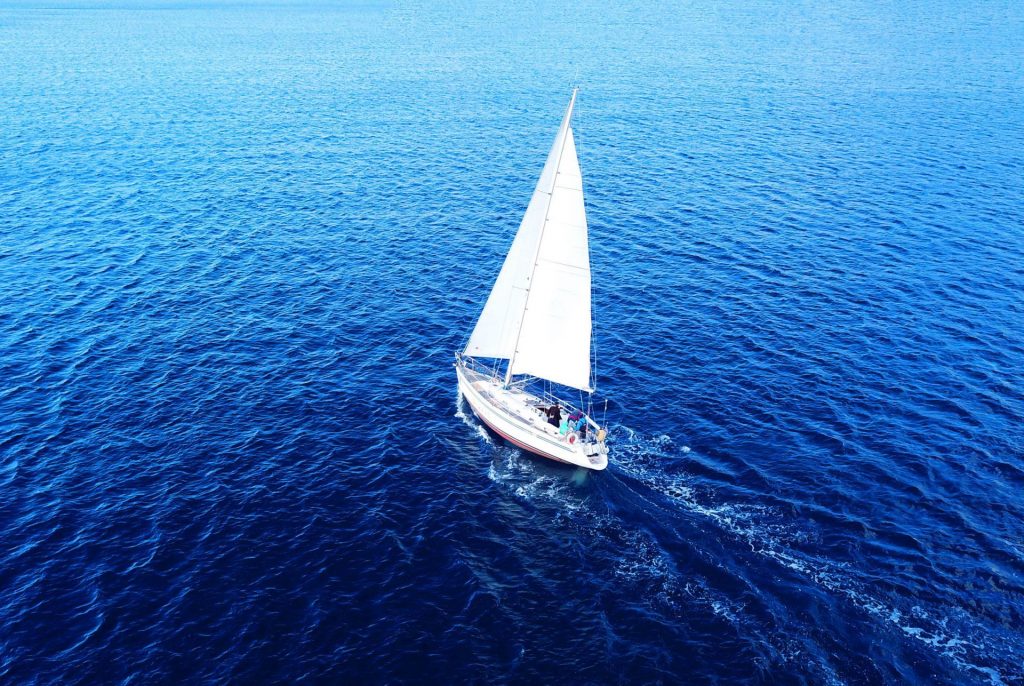
The basics of sailboat design play a significant role in the classification and function of these vessels. Hull shapes, keel types, and construction materials contribute to the speed, stability, and maneuverability of sailboats. Additionally, rigging and sails come in various shapes and sizes, which influence sailing performance and handling.
Key Takeaways
- Sailboats are classified by hull design, rigging, and sails that serve specific purposes.
- Designs and materials have a direct impact on the performance and handling of sailboats.
- A wide range of sailboat types exists, which cater to different needs and preferences.
Basics of Sailboat Design
Sailboats come in various shapes and sizes, designed for different purposes and sailing conditions. One can classify sailboats based on hull types, keel types, and mast configurations. This section will briefly discuss these basic components of sailboat design.
There are mainly two types of hulls: monohull and multihull.
- Monohull : This is the traditional and most common type of sailboat hull. It consists of a single hull, providing stability through the use of a keel or centerboard. Monohulls come in various shapes and sizes, suitable for various sailing conditions.
- Catamaran : Catamarans have two parallel hulls of equal size, offering increased stability and speed compared to monohulls. They are commonly used for cruising and racing.
- Trimaran : Trimarans have three hulls, with a larger central hull and two smaller outrigger hulls. This design offers even more stability and speed than catamarans.
The keel is an essential component in sailboat design, helping with stability and performance. There are various keel types, including:
- Full keel : This traditional design features a long and wide keel that extends along the boat's bottom. It offers good tracking and stability but sacrifices speed and maneuverability.
- Fin keel : Fin keels are shorter and deeper than full keels, providing a better combination of stability and maneuverability. These are common in modern monohull sailboats.
- Bulb keel : A bulb keel features a fin keel with a heavy bulb at the bottom, which concentrates the boat's weight, increasing stability and performance in rough conditions.
- Swing keel or centerboard : Swing keels and centerboards can be raised or lowered, allowing the boat to adapt to different water depths and sailing conditions. They are common in smaller boats and racing sailboats.
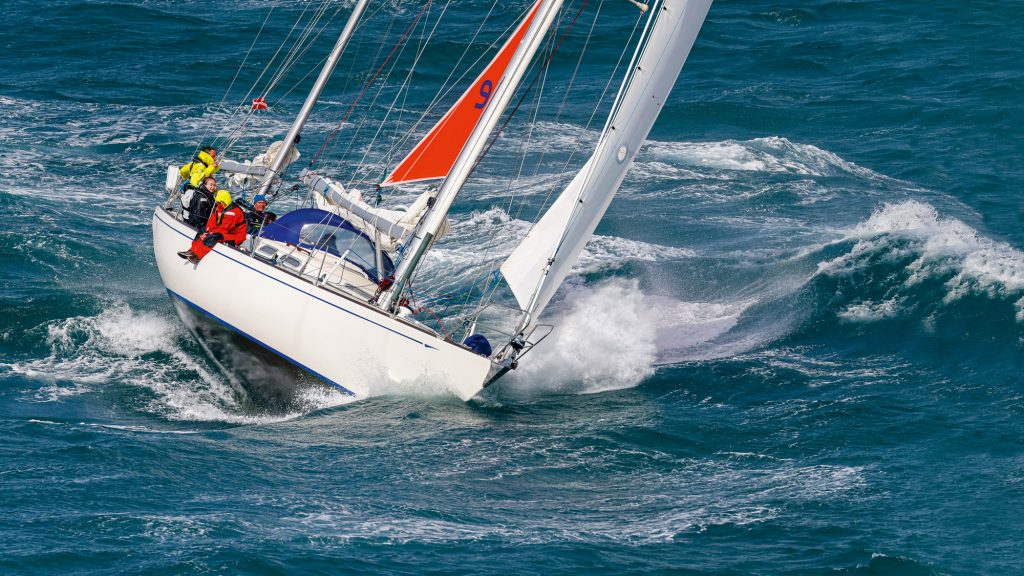
Mast Configuration
The mast configuration affects the sail plan and overall performance of a sailboat. Some common mast configurations include:
- Sloop : This is the most popular mast configuration and features a single mast with a mainsail and a headsail. The simple design makes it easy to handle and suitable for various sailing conditions.
- Cutter : Similar to the sloop, the cutter also has a single mast but carries two headsails, providing more sail area and better performance in heavy weather.
- Ketch : A ketch configuration has two masts: a taller main mast and a shorter mizzen mast. This design offers more flexibility in sail combinations and better balance in different sailing conditions.
- Yawl : Similar to a ketch, a yawl also features two masts but the mizzen is located further aft and is smaller. This design provides better balance and control, particularly in downwind sailing scenarios.
In conclusion, the basics of sailboat design involve selecting the appropriate hull type, keel type, and mast configuration for the desired sailing performance and conditions. Understanding these concepts can help sailors make informed decisions when choosing a sailboat or planning their sailing adventures.
Rigging and Sails
When it comes to sailboats, the rigging and sails play a crucial role in the boat's overall performance and capabilities. This section will briefly cover popular rig types and sail types seen on different sailboats.
There are several types of rigs commonly found on sailboats:
- Sloop : Sloops are the most common type of rig found on modern sailboats. They have a single mast with a mainsail and a single headsail, typically a genoa or jib.
- Ketch : Ketches have two masts, with the main mast taller than the mizzen mast situated aft. They carry a mainsail on the main mast and a mizzen sail on the mizzen mast. Ketches benefit from easier handling and reduced sail area under strong winds.
- Yawl : Similar to ketches, yawls have two masts, but the mizzen mast is smaller and sits further aft, behind the rudder post. Yawls are often chosen for their graceful appearance and improved balance.
- Schooner : Schooners have two or more masts, with the aft mast(s) typically taller than the forward mast(s). Schooners can handle more sails, offering increased sail area for better performance, especially downwind.
- Catboat : Catboats are single-masted sailboats with a single, large mainsail and no headsails. They have a wide beam, which provides stability and ample space for passengers.
- Cutter : Cutters are similar to sloops but carry two headsails, usually a jib and staysail. Cutters may have multiple headsails for increased versatility in various wind conditions.
In addition to the types of rigs, there are also several types of sails used on sailboats, including:
- Mainsail : The primary sail attached to the back of the main mast. It is typically raised on a track or luff groove and managed by a combination of halyard, sheet, and boom vang.
- Genoa : A large triangular sail that overlaps the mainsail, typically used in light winds to provide additional surface area for better performance.
- Jib : A smaller, non-overlapping triangular sail attached to the forestay. Jibs are easier to manage than genoas and are used in a variety of wind conditions.
- Spinnaker : A large, lightweight sail used primarily for downwind sailing . Spinnakers are often brightly colored and shaped like a parachute to catch wind efficiently.
- Staysail : A smaller sail typically used in cutter rigs, positioned between the main mast and the forestay. Staysails provide additional sail area and versatility in varied wind conditions.
Understanding the relationship between sail and rigging can help sailors optimize the performance of their sailboats. With various options for rig types and sail types, each sailboat can be configured to meet the unique needs of its skipper and crew.
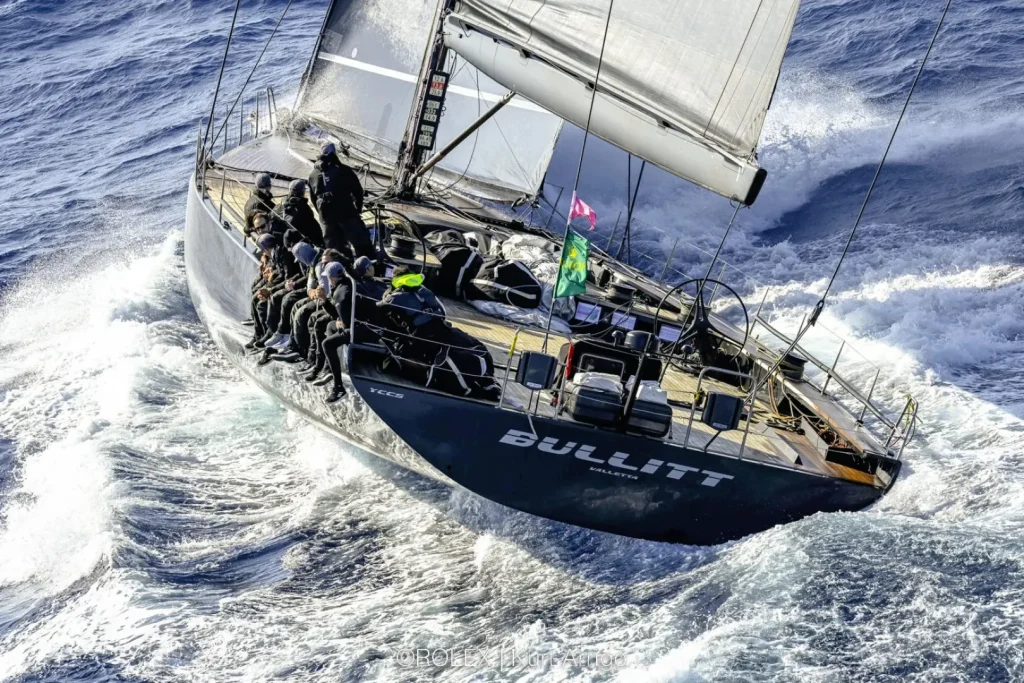
Classes and Types of Sailboats
Monohulls are the most common type of sailboats, consisting of a single hull that provides stability and balance. They come in various sizes and designs, depending on their intended use. Some popular monohull sailboats include the Optimist , Finn, and Sunfish, which are frequently used for racing and recreational sailing. Monohulls tend to have a deeper draft, requiring more water depth than their multi-hull counterparts.
Multihulls, also known as multi-hull sailboats, are a more modern innovation in sailing. They feature two or more hulls connected by a frame or bridgedeck. This design offers increased stability and speed over monohulls. Some common types of multihulls are catamarans (with two hulls) and trimarans (with three hulls). Due to their wider beam and shallower draft, multihulls are particularly suitable for cruising in shallow waters and provide more living space on board.
One-Design Sailboats
One-Design sailboats are a specific class of racing sailboats in which all boats are built to the same design specifications, ensuring that the competition focuses on the skill of the sailor rather than the design of the boat. These boats must adhere to strict rules and standards, with minimal variations allowed in terms of hull shape, sail area, and rigging. Some popular one-design sailboats include the Enterprise and the aforementioned Optimist and Finn sailboats.
Dinghies and Skiffs
Dinghies and skiffs are small, lightweight sailboats that are often used for sailing classes, short-distance racing, or as tenders to larger boats. Dinghies usually have a single mast with a mainsail and sometimes a small jib. Some popular types of sailing dinghies include the Optimist, which is specifically designed for children, and the versatile Sunfish sailboat. Skiffs, on the other hand, are high-performance sailboats primarily used for racing. They have a larger sail area relative to their size and typically include features such as trapezes and planing hulls, which allow for faster speeds and greater maneuverability.
In conclusion, there are various classes and types of sailboats, each with its own unique features and characteristics. From the simplicity of monohulls to the stability and speed of multihulls, and from the fair competition of one-design sailboats to the excitement of dinghies and skiffs, there is a sailboat to satisfy every sailor's preferences.
Sailboat Size and Use
When exploring the world of sailboats, it's important to understand their different sizes and purposes. Sailboats can be categorized into three main types, each with unique characteristics and uses: Day Sailers , Racing Sailboats, and Cruising Sailboats .
Day Sailers
Day Sailers are small sailboats typically ranging from 10 to 24 feet in length. These boats are perfect for short sailing trips and are easy to maneuver for beginners. They have limited accommodations on board, providing just enough seats for a small group of people. Some popular day sailer models include the Laser, Sunfish, and Flying Scot. Lightweight and agile, Day Sailers are often used for:
- Recreation: casual sailing or exploring nearby waters with family and friends
- Training: beginner sailing lessons or practicing sailing techniques
- Competition: local club races or interclub regattas
Racing Sailboats
Racing Sailboats are designed to provide maximum speed, maneuverability, and efficiency on the water. Sizes may vary greatly, from small dinghies to large yachts. Key features of racing sailboats include a sleek hull shape, high-performance sails, and minimalistic interiors to reduce weight.
Career racers and sailing enthusiasts alike participate in various types of racing events , such as:
- One-design racing: all boats have identical specifications, emphasizing crew skill
- Handicap racing: boats of different sizes and designs compete with time adjustments
- Offshore racing: long-distance racing from one point to another, often around islands or across oceans
Cruising Sailboats
Cruising Sailboats are designed for longer journeys and extended stays on the water. They typically range from 25 to 70 feet in length and provide comfortable accommodations such as sleeping cabins, a galley, and storage spaces for supplies and equipment. Sailing cruisers prioritize stability, comfort, and durability for their voyage.
Here are some common types of cruising sailboats:
- Cruiser-racers: These boats combine the speed of a racing sailboat with the comfort and amenities of a cruising sailboat. They are ideal for families or sailors who enjoy participating in racing events while still having the option for leisurely cruises.
- Bluewater cruisers: Designed for handling the world's most demanding ocean conditions, bluewater cruisers are built with a focus on sturdy, self-reliant sailboats that can withstand long-distance voyages and challenging weather conditions.
- Multihulls: Catamarans and trimarans are gaining popularity in the cruising world for their typically more spacious interiors and level sailing characteristics. With two or three hulls, multihulls offer high levels of stability and speed for a comfortable cruising experience.
Understanding the differences between various sailboat types will help potential sailors select the perfect vessel for their sailing goals, skills, and preferences. Day Sailers, Racing Sailboats, and Cruising Sailboats each have their unique features, catering to distinct uses and sailing experiences.
Advanced Sailboat Features
Sailboats have evolved over time, and many advanced features have been developed to enhance performance and safety. In this section, we will discuss some of the key advanced features in modern sailboats, focusing on performance enhancements and safety/navigation.
Performance Enhancements
One critical component that impacts a sailboat's performance is the type of keel it has, which affects stability, resistance, and maneuverability . There are several kinds of keels such as fin keel , wing keel , and bulb keel . Fin keels offer low drag and high efficiency, making them suitable for racing sailboats. On the other hand, wing keels provide better stability at low speeds, while bulb keels provide a lower center of gravity to enhance overall stability and comfort during long voyages.
Another feature that contributes to a sailboat's performance is its sails and rigging. The jib is a triangular sail at the front of the boat, which helps improve its upwind performance. More advanced sailboats use a combination of shrouds , which are the supporting cables running along the sides of the boat, and stays , the cables that help hold the mast in place, to create a stable and efficient rigging system.
A sailboat's performance can also be influenced by the presence of a centerboard or daggerboard , which can be adjusted to optimize stability, maneuverability, and speed. When racing or navigating in shallow waters, retractable centerboards and daggerboards are particularly useful as they provide better performance and versatility.
Safety and Navigation
Safety and navigation onboard a sailboat relies on a combination of advanced gear and equipment. A modern sailboat is usually equipped with:
- GPS and chartplotters to assist with navigation and planning routes
- VHF radios for communication with other vessels and authorities
- Radar to detect obstacles, weather systems, and other vessels
- AIS (Automatic Identification System) which helps monitor nearby vessel traffic
The design of a sailboat's hull, rigging, sails, and hardware also contribute to its safety. The boom , the horizontal pole that extends the sail, should be properly secured and designed to avoid accidents while sailing. The keel , whether it's a fin, wing, or bulb keel, plays a vital role in the overall stability and safety of the sailboat. The choice of keel should be based on the intended use of the sailboat and the prevailing sailing conditions.
In summary, advanced sailboat features significantly improve the performance, safety, and navigation capabilities of modern sailboats. Innovations in keel design, rigging systems, and onboard navigational equipment have undoubtedly contributed to the overall enjoyment and safety of sailing.
Sailboat Ownership
Buying Considerations
When considering buying a sailboat , it is important to understand the different types of sailboats available and the purpose each serves. Sailboats can be broadly categorized into three types:
- Racing sailboats: Designed for speed and performance, with minimalistic interiors and advanced sail systems.
- Cruising sailboats: Built for comfort and longer trips, featuring more spacious interiors and amenities.
- Daysailers: Smaller, easy-to-handle boats that are often used for short trips and recreational sailing.
Prospective boat owners should consider factors such as boat size, type, budget, and intended use (solo vs. family sailing, charter operations, etc.). It's also essential to evaluate the availability of necessary gear and the level of experience required to handle the chosen sailboat.
Maintenance and Upkeep
Sailboat ownership involves maintenance and upkeep to ensure the boat remains functional, safe, and holds its value. Some common maintenance tasks include:
- Hull cleaning and inspection: Regularly inspect the hull for damages and clean off any growth to maintain performance and fuel efficiency.
- Antifouling paint: Apply antifouling paint to prevent marine organisms from attaching to the hull, which can negatively impact the boat's performance.
- Engine maintenance: Check and replace engine oil, inspect cooling and fuel systems, and clean or replace air filters.
In addition to regular maintenance, sailboat owners should also be prepared to replace or repair critical systems and components, such as:
- Sails: Monitor the condition of your sails and replace them as needed to maintain performance and safety.
- Rigging: Regularly inspect and maintain the standing and running rigging, and replace worn or compromised parts.
- Electronics and instruments: Ensure navigation systems, radios, and other electronic equipment are functioning properly.
Taking proper care of a sailboat can be time-consuming, and some owners may choose to charter their boats when not in use as a way to offset ownership costs. Others may opt for hiring professionals to manage routine maintenance, particularly when sailing solo or with limited sailing experience.
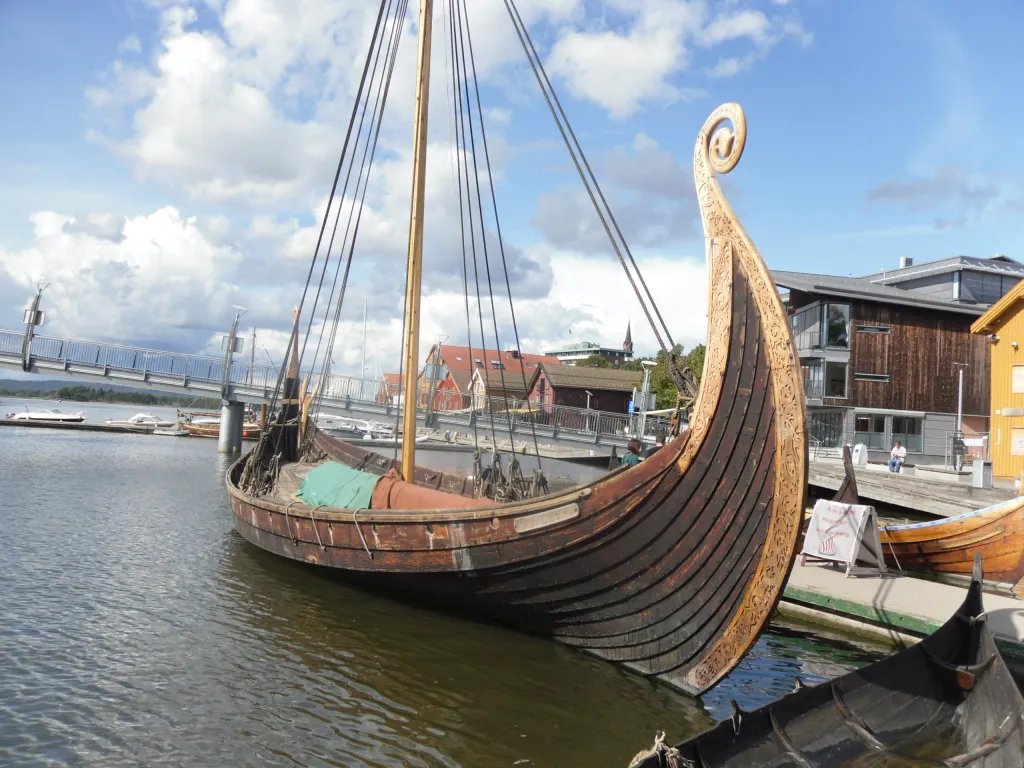
Historical and Special Sailboats
Tall ships and gaffers.
Tall Ships are large, traditionally rigged sailing vessels with multiple masts, typically square-rigged on at least one of their masts. Some examples of these ships include the clipper, brig, and square-rigged vessels. The clipper is a fast sailing ship known for its sleek hull and large sail area, while the brig features two square-rigged masts. Square-rigged ships were known for their impressive sail area and could cover large distances quickly.
Gaffers are a subset of historical sailing vessels with a gaff mainsail as their primary sail type. This gaff-rig is characterized by a spar (pole) that extends the top edge of the mainsail, giving it a quadrilateral shape to optimize wind coverage. Gaff mainsails were commonly used in England and influenced the development of other sailing vessels.
Classic and Antique Sailboats
Classic and antique sailboats refer to older, traditionally designed sailing vessels that have been preserved or restored. They often feature wooden construction and showcase a variety of rigging types, including gaff rigs and square rigs. These historical sailboats have unique designs, materials, and techniques that have since evolved or become rare.
Here are some examples of antique and classic sailboats:
- Sloop : A single-masted sailboat with a Bermuda rig and foresail
- Cutter : A single-masted vessel with a similar rig to the sloop, but with additional headsails for increased maneuverability
- Ketch : A two-masted sailboat with a smaller mizzen mast aft of the main mast
In summary, historical and special sailboats encompass a wide range of vessel types, from large, multi-masted tall ships to smaller, single-masted gaffers and classic sailboats. These vessels reflect the rich maritime history and the evolution of sailing techniques and designs over time.
Sailboat Culture and Lifestyle
Sailboat culture and lifestyle encompass a variety of aspects including racing events, leisurely cruising, and exploring new destinations. The main types of sailboats include racing yachts, cruising sailboats, and motorsailers, each offering a unique experience for sailors.
Regattas and Racing Circuits
A popular aspect of sailboat culture involves participating in regattas and racing circuits . These events create a competitive atmosphere and develop camaraderie among sailors. Racing sailboats are specifically designed for speed and agility , and sailors often team up to compete in prestigious races such as the Rolex Sydney Hobart Yacht Race or the America's Cup. Yacht clubs play an essential role in cultivating this competitive sailing environment.
Sailboat Charter and Tourism
Another facet of sailing culture is the sailboat charter and tourism industry, which allows people to experience the cruising lifestyle without owning a sailboat. Charters are offered for various types of sailboats, from family-sized cruising vessels to luxurious superyachts . Yacht sailing provides tourists with a unique travel experience, as they can explore diverse destinations, immerse themselves in local cultures, or simply relax on the open water.
Cruising sailboats are designed to provide comfortable living spaces and amenities, making them perfect for longer journeys or exploring remote destinations. Motorsailers, on the other hand, are equipped with both sails and engines, offering versatility and convenience for sailors.
Some popular sailing destinations include the Caribbean, Mediterranean Sea, and the South Pacific. These regions offer beautiful scenery, rich cultural experiences, and ideal sailing conditions.
The sailboat culture and lifestyle attract individuals who enjoy adventure, exploration, and camaraderie. From competitive racing events to leisurely cruising vacations, sailing offers diverse experiences that cater to a wide range of interests.
Frequently Asked Questions
What are the distinguishing features of different sailboat classes?
There are various sailboat classes, each with its own distinguishing features. Monohulls, for example, are the most common type of sailboat and have a single hull. Multihulls, such as catamarans and trimarans, have two or three hulls, respectively. These differences in hull design often affect the boat's stability, speed, and maneuverability.
Which sailboat types are best for novice sailors?
Novice sailors often benefit from starting with smaller, more manageable boats. Sailing dinghies and daysailers are popular choices due to their simple rigging and ease of handling. These boats typically have a single mast and a limited number of sails, making them ideal for beginners to learn sailing basics.
What are common types of small sailboats ideal for day sailing?
For day sailing, small sailboats such as sailing dinghies, day sailers, and pocket cruisers are ideal options. These boats usually range between 12 and 25 feet in length and offer simplicity, ease of handling, and portability. Examples of common day sailing boats include the Sunfish, Laser, and O'Day Mariner.
How do the purposes of various sailboat types vary?
Sailboats serve different purposes based on their design, size, and features. Daysailers and dinghies are ideal for short trips, sailing lessons, and casual outings. Racing sailboats, with their lighter weight and streamlined design, are built for speed and competition. Cruising sailboats, on the other hand, are designed for longer voyages and often include living quarters and additional amenities for comfortable onboard living.
What is considered the most popular class of sailboat for recreational use?
The most popular class of sailboat for recreational use often varies depending on individual preferences and local conditions. However, monohulls are commonly preferred due to their widespread availability, versatility, and affordability. Within the monohull class, boats like the Sunfish, Laser, and Catalina 22 are popular choices for their ease of use and adaptability to various sailing conditions.
Could you describe a sailing dinghy designed for two people?
A two-person sailing dinghy typically has a simple rig with a single mast and one or more sails, making it easy to handle for both experienced and novice sailors. The RS Venture , for example, is a popular choice for two-person sailing. It features a spacious cockpit, durable construction, and simplicity in its rigging and control systems. These characteristics make it an excellent option for recreational sailing, training, and even racing.
Related Articles

Seavee Boats: The Ultimate Guide for Enthusiasts
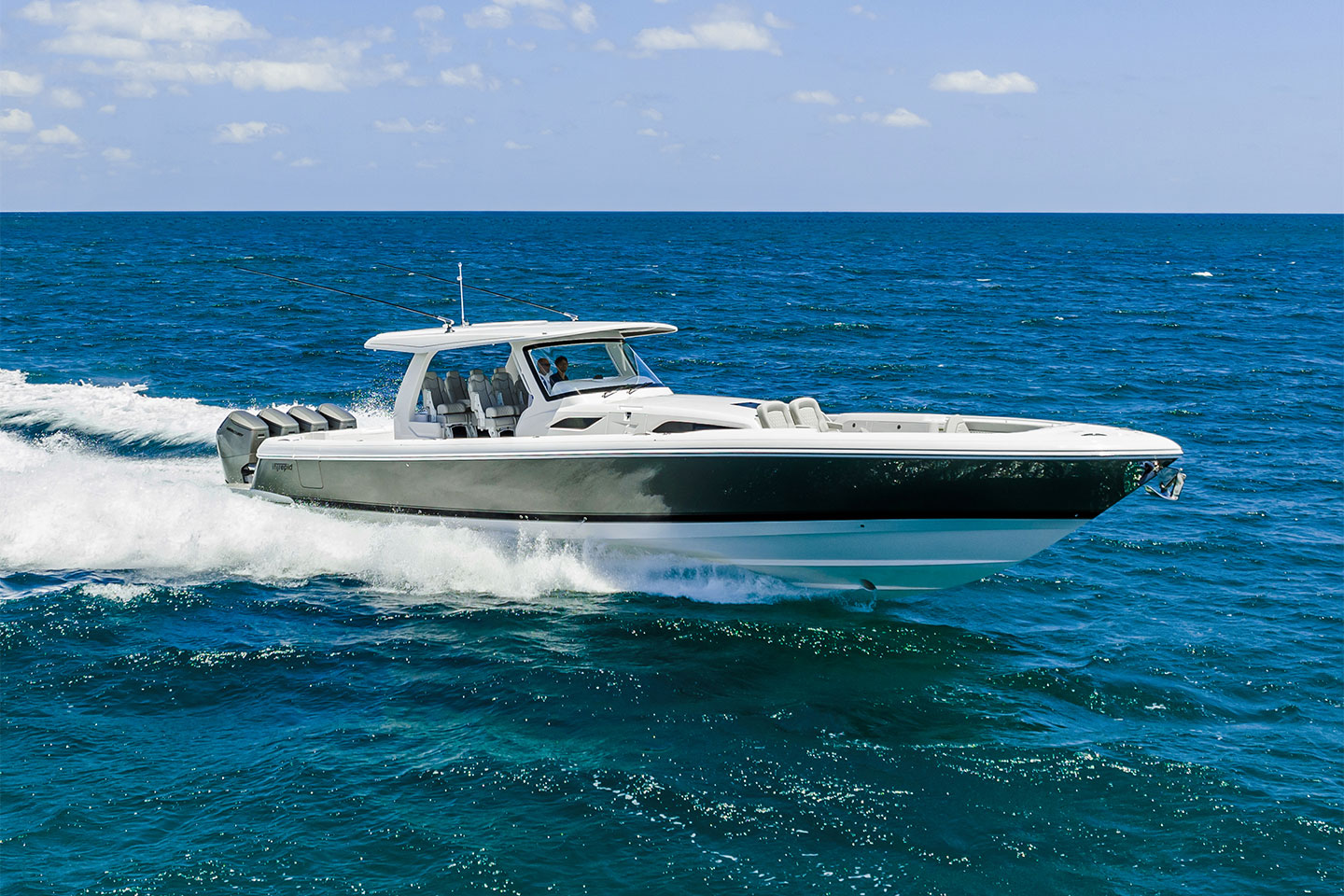
INTREPID POWERBOATS AT THE 2024 PALM BEACH INTERNATIONAL BOAT SHOW

Seaboard Marine: Enhancing Global Shipping and Logistics Solutions
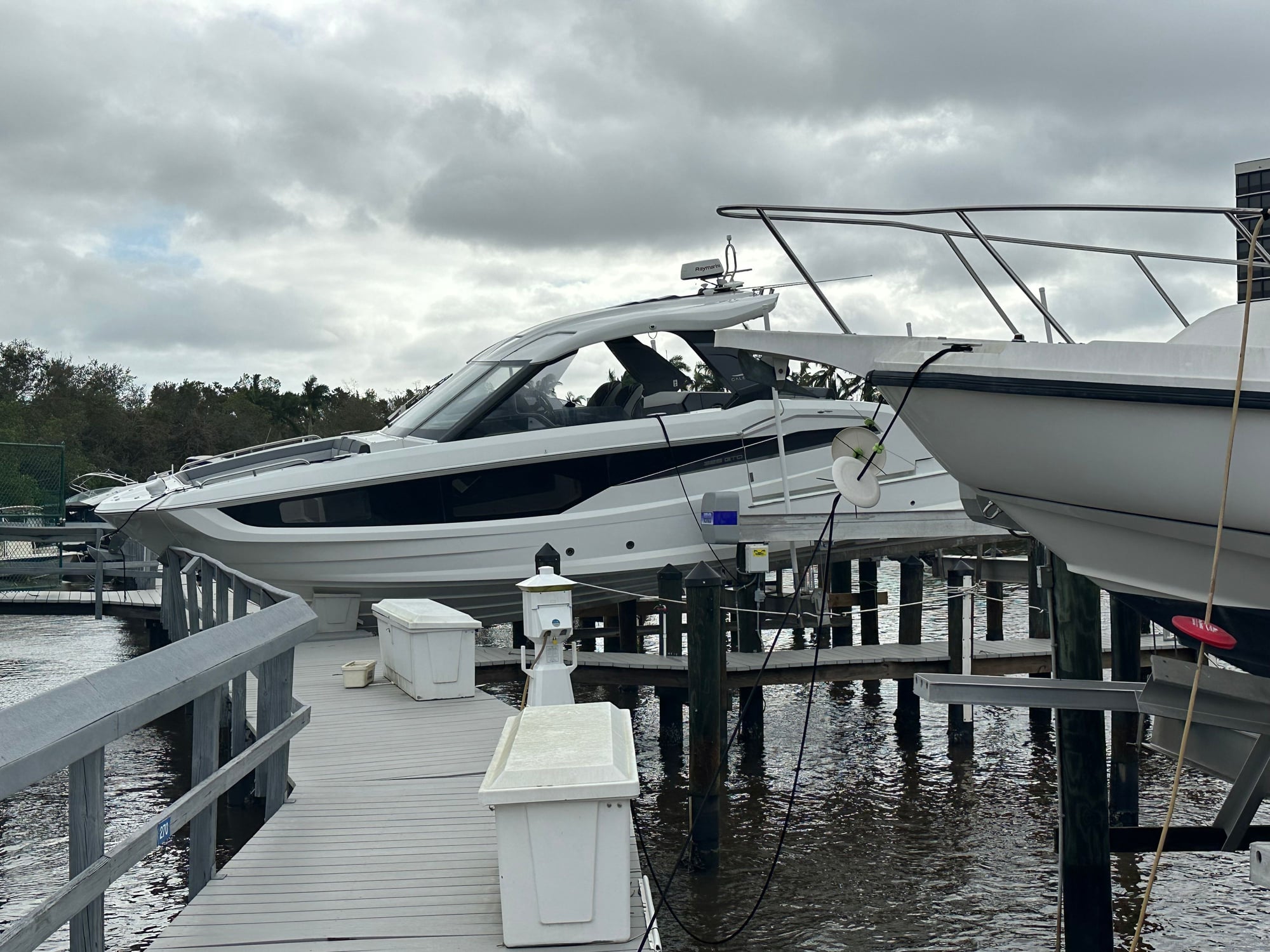
Is Your Boat Ready for 2024's Extreme Hurricane Season? Solidify Your Plan and Meet Insurer Expectations

Tom Brady Yacht: Exploring the Luxurious Vessel of a Football Legend

Bow of a Boat: Essential Guide to Understanding Its Importance
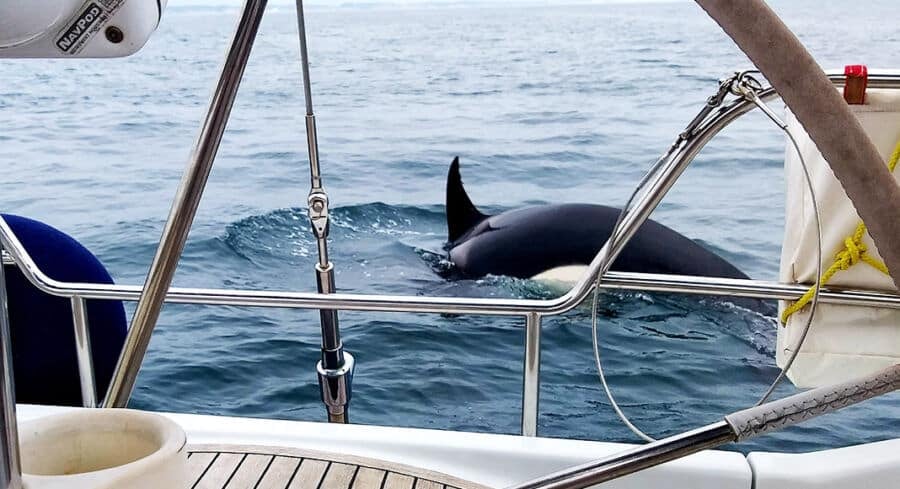
Orcas Attacking Boats: A Rising Concern for Maritime Safety
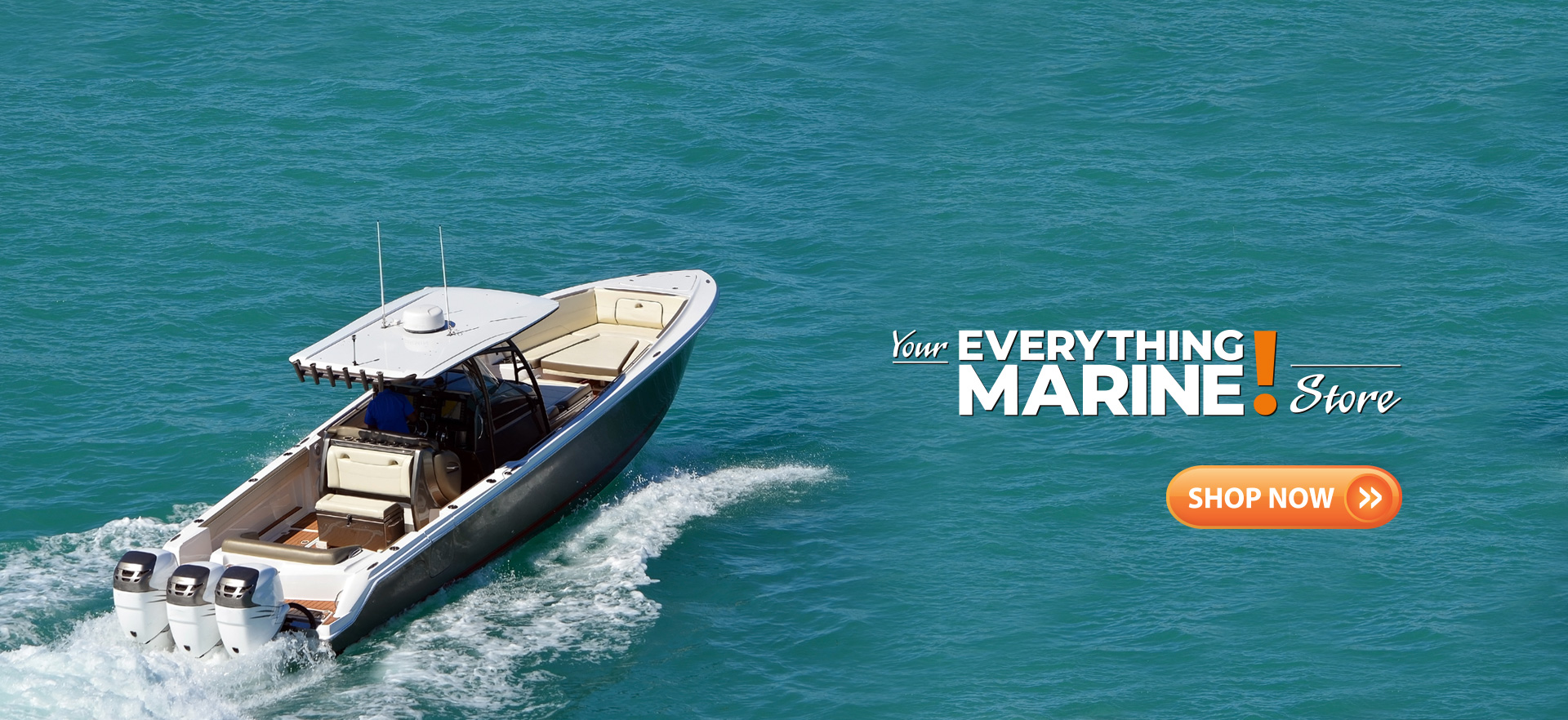
A Complete Review of Boat Owners Warehouse: Uncovering the Essentials for Boating Enthusiasts
The 15 Different Types Of Sailing Ships
The 15 types of sailing ships are listed below.
- The Schooner
- The Carrack
- The Brigantine
- The Barquentine
- The Clipper
- The Windjammer
- The Fully Rigged Ship
Throughout centuries, there have been many different types of sailing ships seen from harbors and coastlines around the world.
This article will show the various types of sailing vessels that have made their mark in maritime history and we showcase their purposes and why they are still remarkable feats of marine engineering.
The different sizes, shapes, and masts of the ships required different numbers of sailors to handle them and each type of ship was crafted with a different purpose in mind.
All ships are unique with no two types of ships being the same with each coming with its own experiences, features and requirements.
1. The Schooner
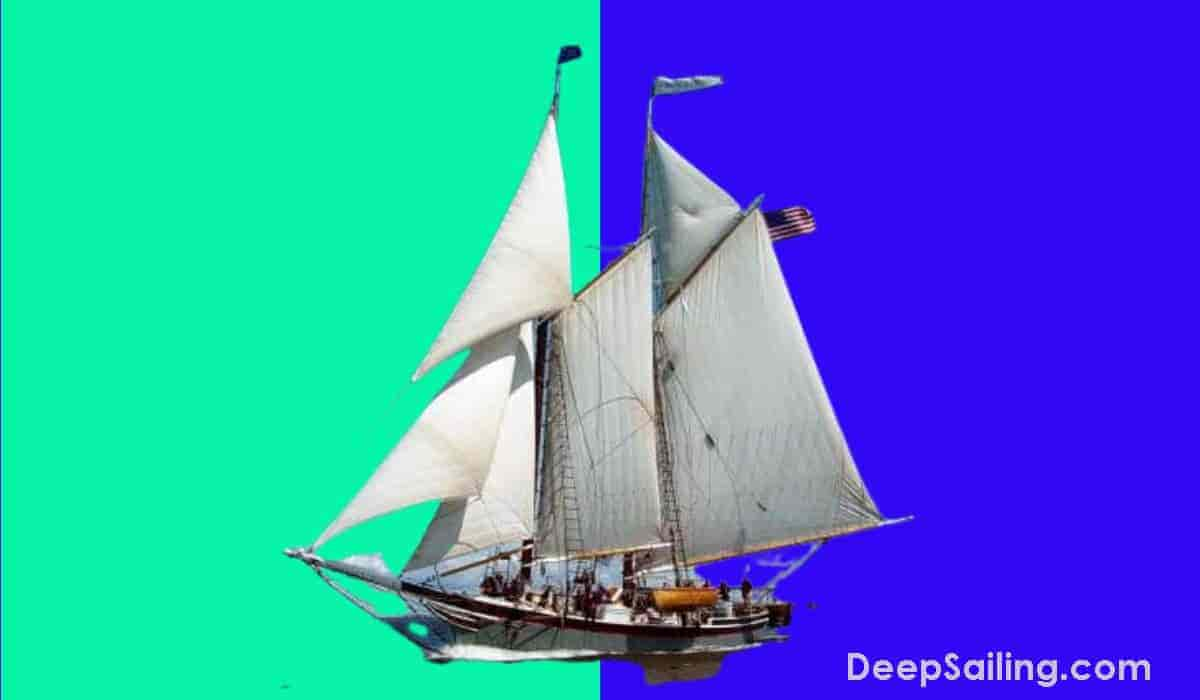
The Schooner sailing vessel, with an average size of 46m (152 feet) in length, was developed in the early 17th century and first used by the Dutch.
The ship came with fore and aft sails and they were created to operate in the toughest of wind and ocean conditions.
The Schooner was a multi-purpose sailing vessel used for transporting slaves to transporting cargo and it was used for fishing and racing too.
There are 5 different schooner types that are characterized by their rig configurations listed below.
- Tern schooner : This was a 3-masted schooner most popular between 1880 and 1920 capable of carrying up to 400 tons in cargo and it required a crew of 6-8 people
- 4-6 masts schooner : These schooners spread the sail area over smaller sails
- Grand Bank Fishing schooner : Similar to the famous Bluenose, it carries the main gaff topsail and a fisherman's staysail set between the masts.
- Square Topsail schooner : This was a combination of fore and aft sails and small square sails, most popularly used for coastal cargo transportation in the 1800s
- Coastal schooner : This was a coastal schooner sailing ship used for carrying goods and general cargo to nearby islands along the coast ( 1 )
The 19th Century schooner came with two or three masts, the one at the fore being shorter than the others.
Modern schooners, with Bermuda rigged sails, remain powerful, economical coastal liners traversing the Pacific.
Famous schooner sailing ships are listed below.
- America : The Schooner named " America " was designed for racing and it became the first winner of the America's Cup international sailing trophy ( 2 )
- Thomas W Lawson : The schooner “ Thomas W Lawson ” had a unique seven masts, with interchangeable sails and gear
- Wawona : The schooner " Wawona " was one of the largest lumber carriers and fishing vessels between 1897 and 1947
2. The Carrack
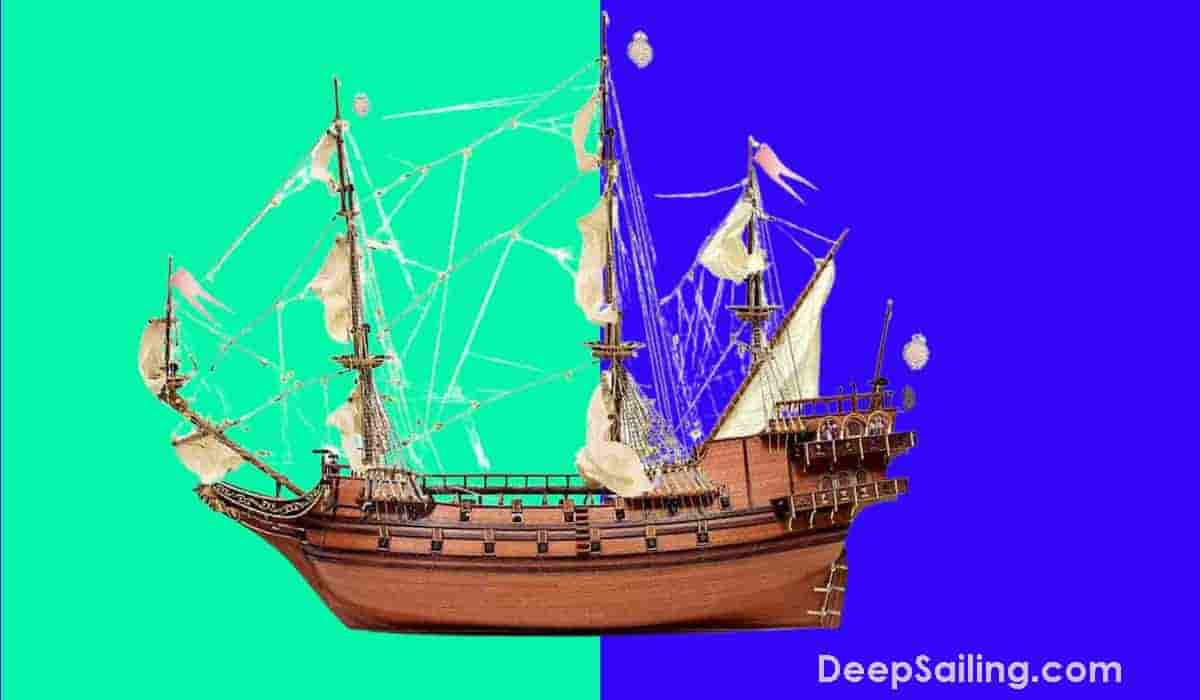
The Carrack, developed in the 14th and 15th centuries with the first built in Portugal, is a nautically-rigged wooden ship with three or four masts each having square sails or triangular sails and it was heavily used between the 14th to 15th Centuries and remained popular until the 18th Century. It is the sailing ship Christopher Columbus used to sail the world.
It was the largest ship in Europe with the Spanish Carrack being more than 1,000 tons in weight and 150 feet (45 meters) in length. More modern versions of the Carrack were developed by the Portuguese and they could hold up to 2,000 tons. ( 3 ).
The Carrack had 4 decks with the lower 2 used for cargo, the 3rd was for accommodation and the 4th was for cargo owned by the crew ( 4 ) and this bulky ship was the standard trading ship along the Baltic, Mediterranean, Asian, and Atlantic coasts in the mid-16th century useful for carrying cargo across seas.
The Carrack had a strange shape which made it cumbersome to sail close to the wind and after a lot of engineering experiments, parts of the ship were stripped off giving the ship a high stern and a low bow.
The modern Carrack features a square-rigged mainmast, foremast, and a latten-rigged Mizzen mast, along with a rounded stern, sizable bowsprit, forecastle, and aft castle.
This is a large ship, built to carry heavy freight for long-distance hauls since it was very steady even in the worst weather with the British Army calling it the “Great Ship” because of its highly-functional ship design.
Famous carrack shipping vessels are listed below.
- Santa Maria : This was the famous ship that Christopher Columbus used to sail and discover America in 1492
- Victoria : The first ship to circumnavigate the globe
- Grace Dieu : This was commissioned by King Henry V and it was one of the largest carrack ships in the world in 1418
- Cinco Chagas : This was presumed to be the richest ship at that time. it was sunk in battle in 1594 ( 5 )
3. The Brigantine
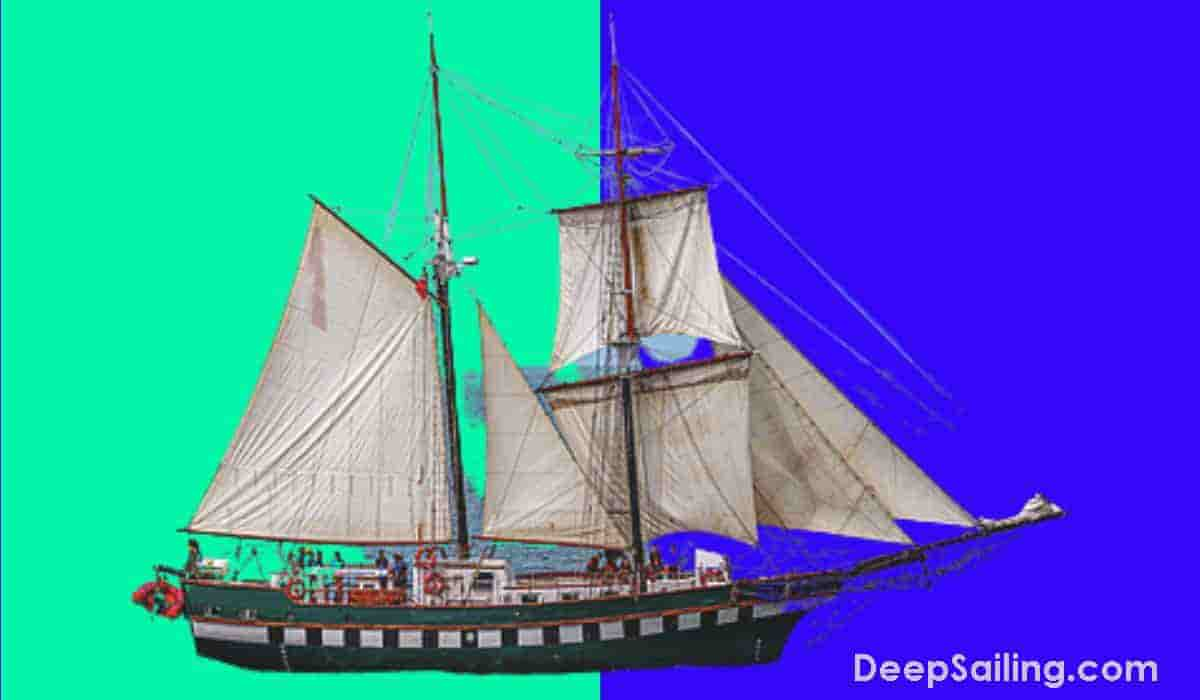
A Brigantine is a two-masted sailing ship with the main mast both a fore-and-aft main sail, a triangular type of sail and a square main topsail that came in various sizes ranging from 30 tons to 150 tons and it could carry a crew of up to 125 people but the shipping vessel could still be handled by a smaller crew if needed.
These ships were similar to the sailing vessel called the Brig as they both had top-gallant sails and were used by the Royal Navy to scout and monitor enemies on the high seas while also being popular amongst pirates as they were faster and easily maneuverable sailing vessels.
It is unclear when the ship was originally built with loose definitions date the ship back to the 13th century when it was originally referred to as the "sail and oar-driven war vessel" ( 6 ) and early academic definitions where the vessel was referred to as the "Brigantine" was first seen in books in the early to mid-16th century ( 7 ).
They would sail across the trade routes of the Baltics and Northern Europe, all the way from Germany to Scandinavia.
The mid-size ships had two sails on the-mainmast with a stripped-down fully-squared rig.
4. The Barquentine
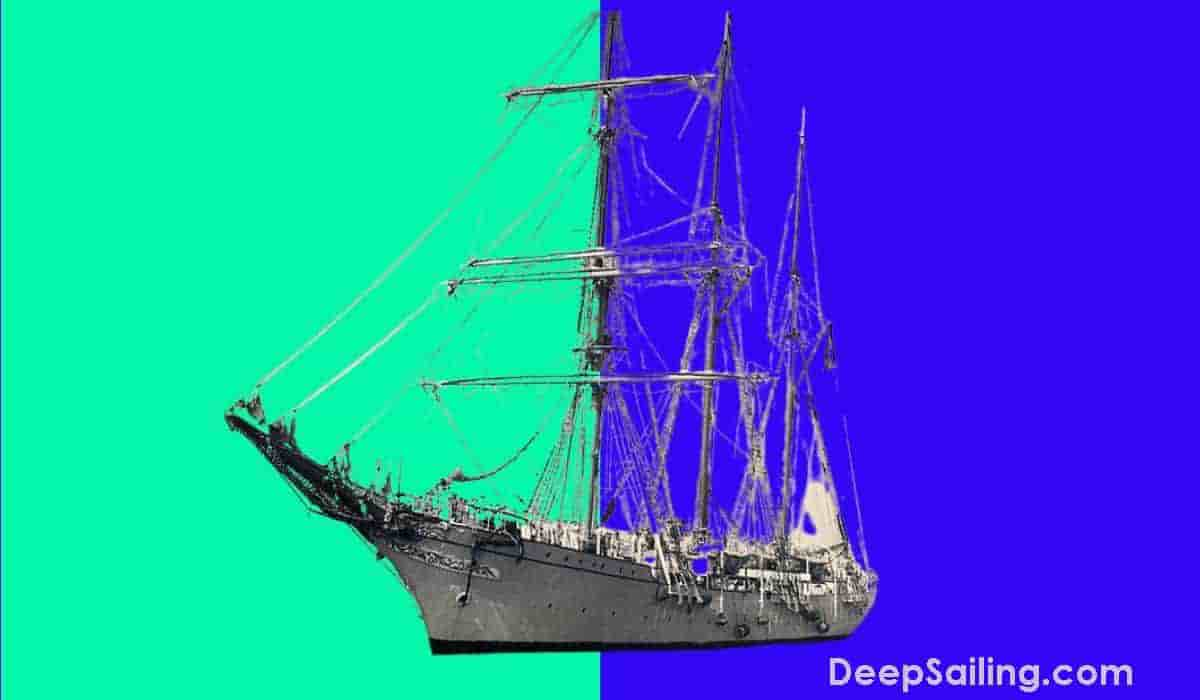
The Barquentine, first built in the 17th century and also referred to as a " schooner barque ", " barkentine " or " schooner bark ", is a sailing ship similar to a barque but with only the foremast square-rigged and the remaining masts rigged fore and aft ( 9 ). They weighed 250 to 500 tons.
The Barquentine has three or more masts and square sails on the fore and aft masts with the main mast had topmast and gaff sails and these had been stripped down to facilitate operation by a slimmer crew and basic rig.
The Barquentine sailed the waters of Northern Europe which were dominated by variable wind speeds and they were popularly used to carry lumber from Scandinavia and Germany to England and the Baltic Areas.
5. The Xebec
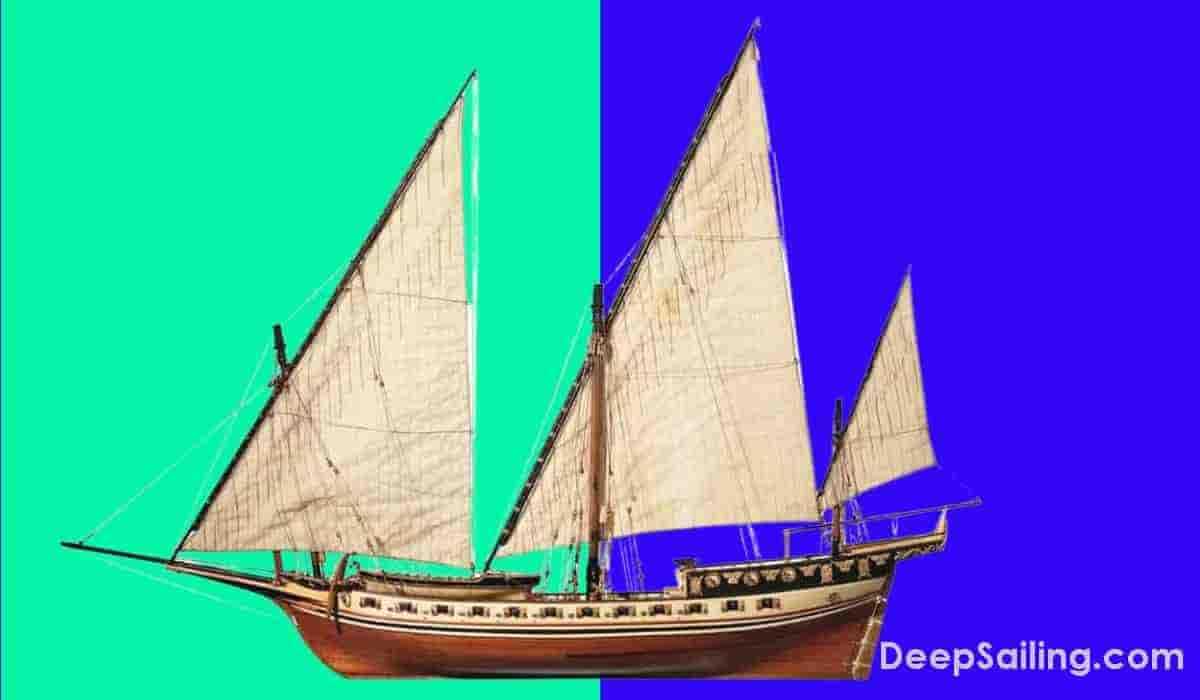
The Xebec, also known as " Zebec ", a name derived from the Arabic word for "Small Ship", was a sailing ship built in the 16th to mid-19th century that was used mainly for moving cargo.
The Xebec sailing vessel held between 90 and 400 crew and was 103ft 9 inches in length with a tonnage of between 200 - 300 tons ( 10 ) and they were very agile and popular with European navies.
The features of the Xebec are listed below.
- Long-prow bulkheads
- Narrow elongated hulls
- Huge lateen yards
- One aft-set mizzen mast
- 3 lateen-pillared masts, both raked forward and having a single triangular sail
Their shallow draft and lateen rig allowed for a closer pinch to the wind allowing them to flee quickly or turn around and fire a broadside volley quickly.
After a lot of engineering experiments, the Xebec gave rise to the Polacre-Xebec, which replaced the mizzen mast. The mainmast of the new derivative also had a square rig and these new vessels were light and could not carry a heavy load with the shallow draft and low free-board making them unsuitable for open-seas sailing.
6. The Barque
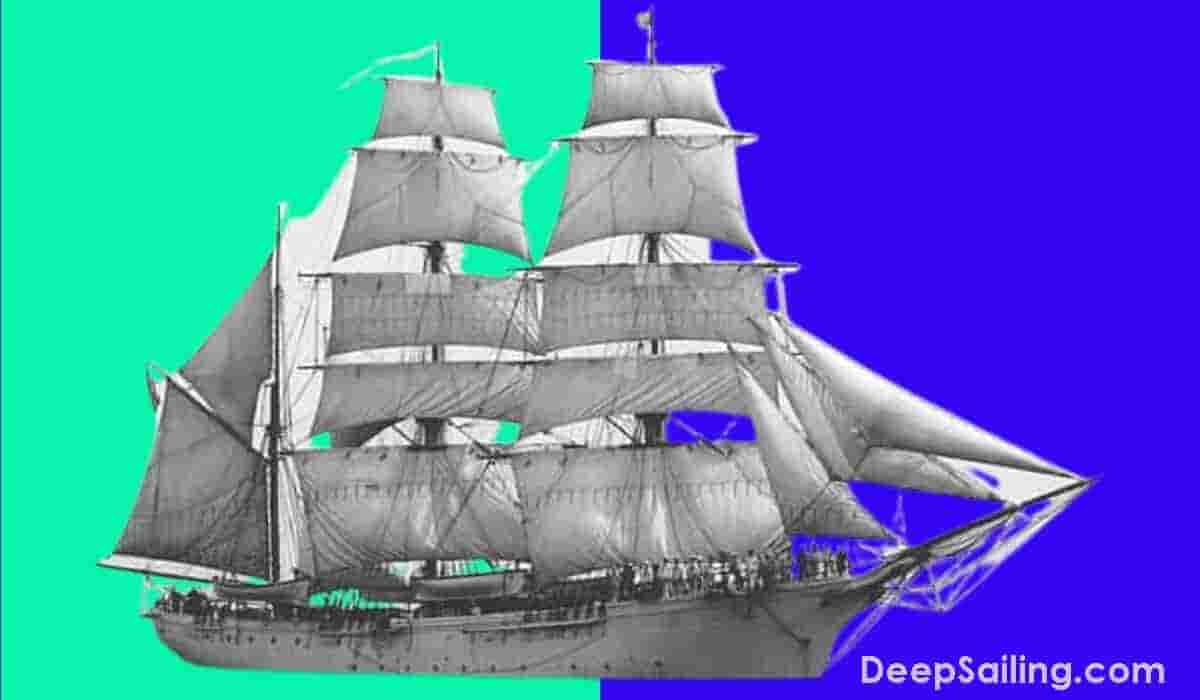
The barque, also referred to as " barc " or " bark ", is a sailing ship first introduced in the 15th century ( 11 ) with 3 or more masts with square sails on all masts, except the aft or mizzen mast. It could carry approximately 500 tons and could hold a crew of 100 people.
Although they are quite similar, the barque should not be confused with the Schooner Bark which is a different vessel.
The Barque ship was commonly used by traders to carry extremely high volumes of cargo from Australia to Europe with cargo mainly consisting of Nitrates and Guano destined for the Western South American coast and they were popular in the period prior to the start of World War II.
7. The Clipper
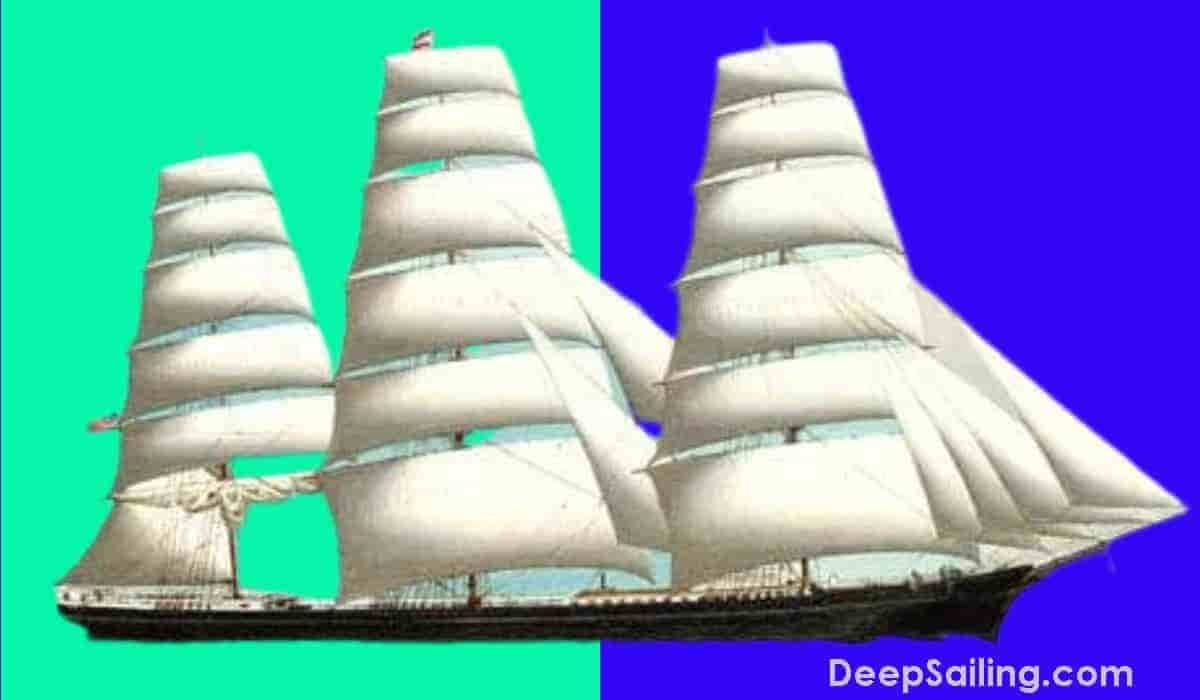
A clipper was a sailing vessel introduced in the mid-19th century that was mainly used as a merchant ship for transporting goods and it was designed for speed.
Clipper ships ranged in size from a few hundred tons to over 4000 tons ( 12 ) and they all had a narrow build, a protruding stern, 3 to 5 masts for speed, and a square rig.
They were most commonly used by British and American traders to ship goods from China to their countries and they were also used to ferry Gold and Tea back to Great Britain and the Americas.
Famous clipper ships are listed below.
- Cisne Branco : This is a steel-hulled built like the original clipper. It is used as a training vessel by the Brazilian navy to this day
- Race Horse : This clipper ship set the record of getting from New York to San Francisco in 109 days in 1850 which was a record at that time
- Marco Polo : This clipper vessel was the first boat of the time to make around trip between England & Australia in under 6 months in 1852
8. The Windjammer
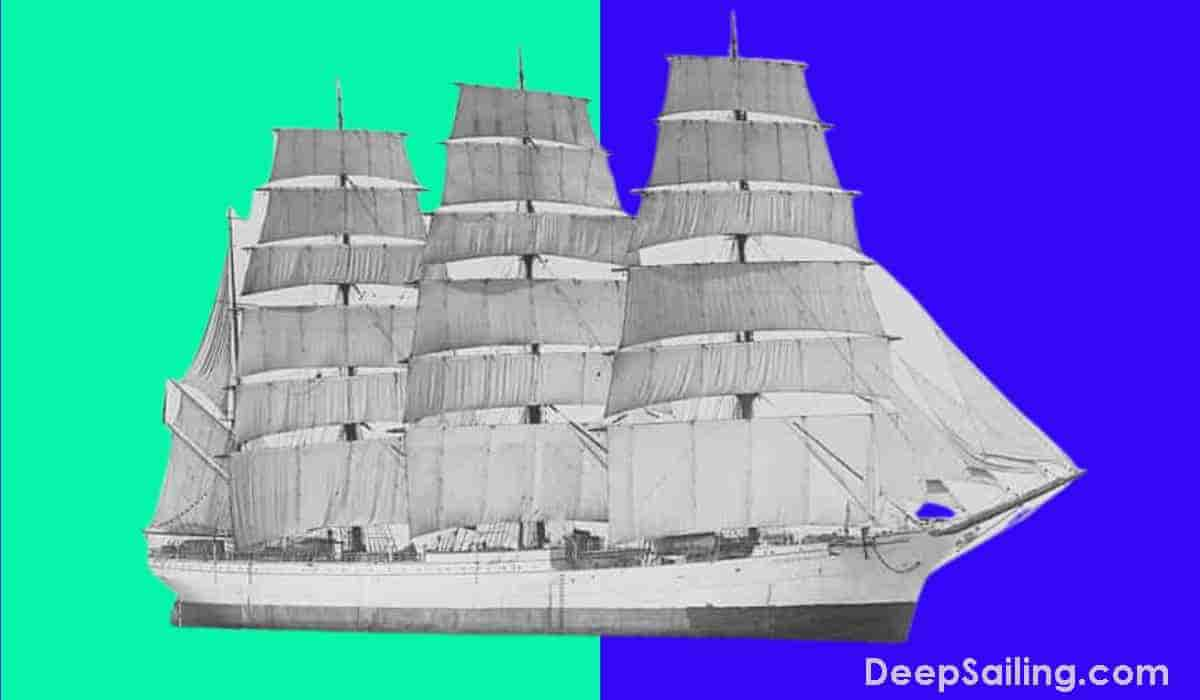
The Windjammer is a commercial sailing ship built in the 19th century with a capacity between 2,000 to 8,000 tons and the speed ranged from 14 to 21 knots ( 13 ).
It came with three to five square-rigged masts and it had a cost-effective extended hull that allowed for larger storage space.
It was a general-class merchant ship and was mainly used to transport bulky cargo and it ferried lumber, coal, and many other goods from one continent to another before evolving from carrying cargo to carrying passengers on cruises in later generations.
9. The Fluyt
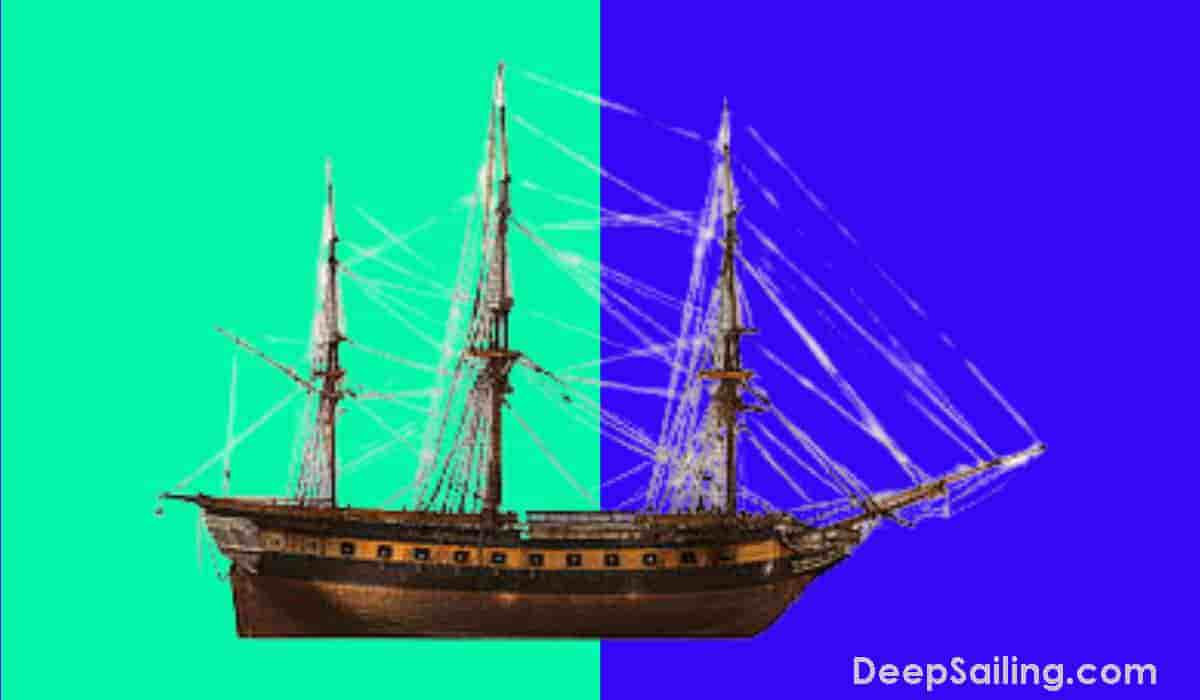
The Fluyt, also known as " fleut " or " fluit " is a sailing ship that originated in the 16th century in the Dutch Republic with a weight between 200 and 300 tons, approximately 80 feet (24 meters) in length, and a crew capacity of 12 - 15 people ( 14 ).
The Fluyt has three squared-rigged masts and was primarily used as a merchant ship to transport cargo.
It was lightly fortified, had a small stern and extended box-style structure, and was crafted using specialized tools to reduce the costs of production and make them affordable to merchants.
10. The Fully-Rigged Ship

A fully rigged ship, also referred to as a "full-rigged ship", is a sailing ship with three or more masts, with all of the masts being square-rigged and the rig, hull, mast, and yards made of iron, wood, or steel.
A full-rigged ship weighed an average 325 tons and could carry a crew of up to 36 people and these ships required a larger crew because of their fully rigged construction ( 15 ).
During the 18th century, a full-rigged ship was also referred to as a " frigate " and they were mainly used for patrolling and for attacking.
A full-rigged ship weighed an average 325 tons and could carry a crew of up to 36 people ( 16 ).
However, towards the end of the 19th century, these ships were stripped down so they could be handled by a smaller crew which helped in easier handling of the sails during the monsoon period when winds would change speed and direction without any warning.
This helped in easier handling of the sails during the monsoon period when winds would change speed and direction without any warning.
A fully rigged ship masts from stern to bow consists of: ( 17 )
- Mainmast : This is the tallest mast on the ship
- Foremast : This is the second tallest mast on the ship
- Mizzenmast : This is the third tallest mast on the sailing vessel
- Jiggermast : If there is a 4th mast, it will be the jiggermast and will be the smallest mast on the ship
11. The Cutter
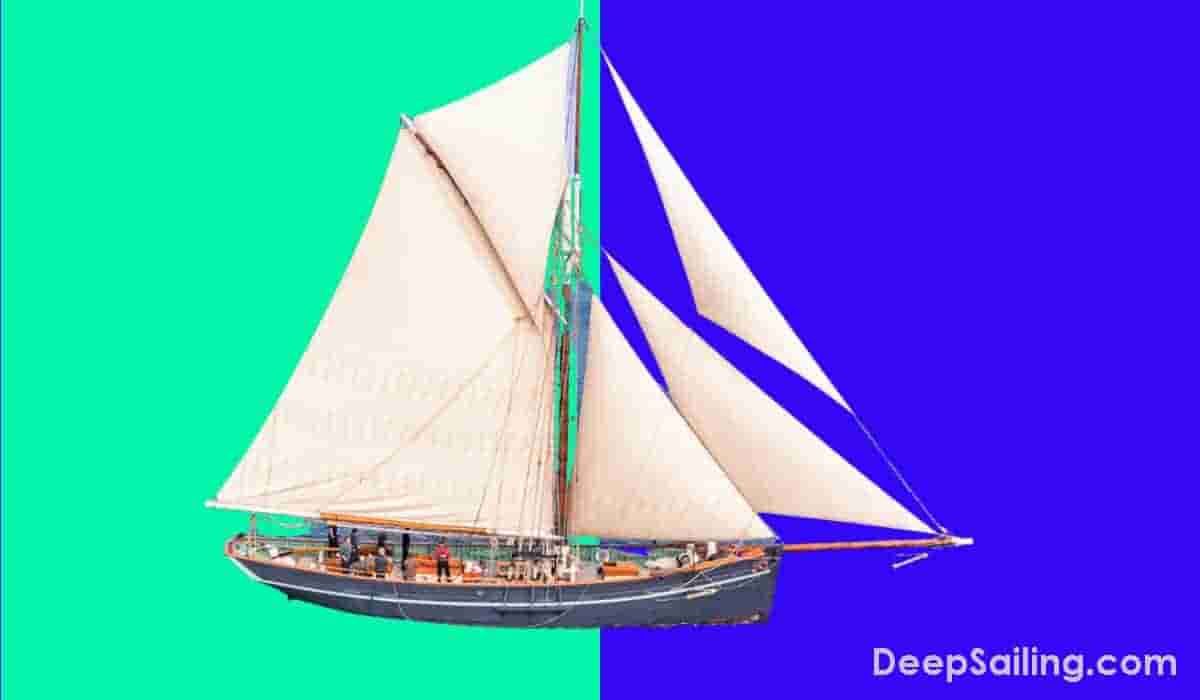
The cutter is a smaller sailing ship built in the early 18th century with a single mast rigged fore and aft and it varied in size from 20ft to 34 ft in length on average with a crew capacity of between 21 to 66 people ( 19 ).
A cutter sailing vessel features: ( 18 )
- Narrow hull
- 2 or more headsails
- Decked sailcraft
- Raking transom
- Vertical stem
- A gaff-rigged long bowsprit
This sailing ship was used for patrolling territorial waters and other enforcement activities during the 18th century and it was used to ferry soldiers and government officials because it was very fast and could outrun any enemy.
Modern-day cutters have a rugged appearance, are small and aptly fit into their intended purpose – speed and agility and the British Sailing Club still has open-oared cutters in their fleet of sailing ships.
12. The Yawl
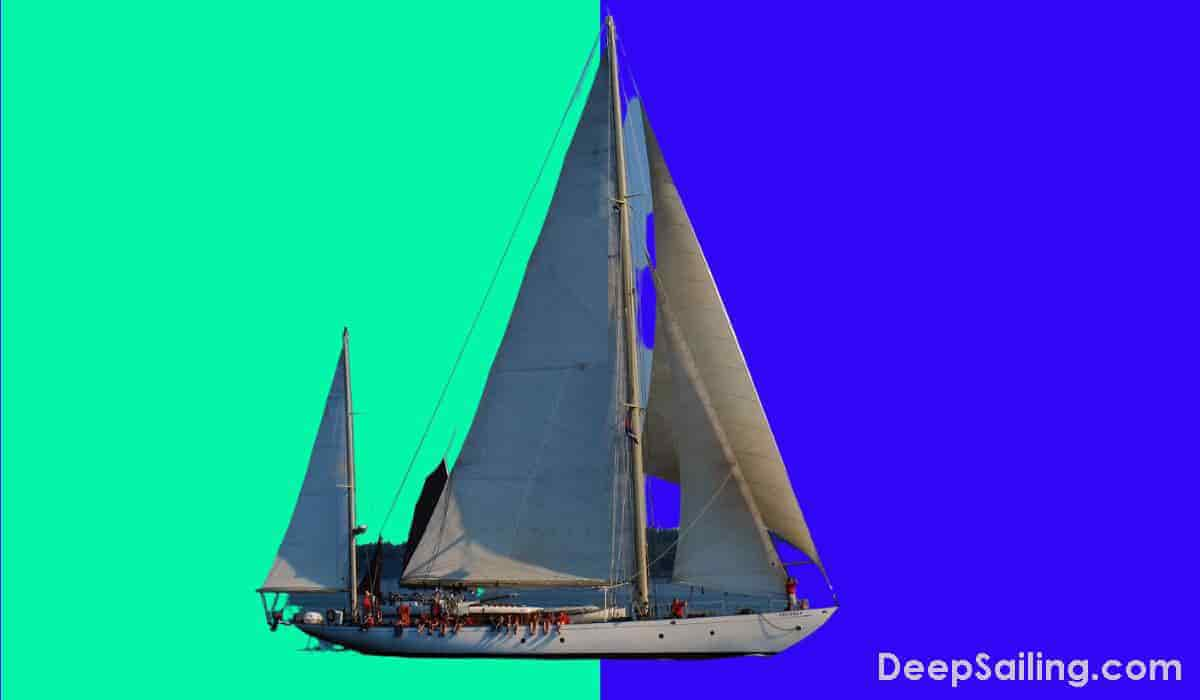
A Yawl is a sailing ship that was originally that was originally a dutch ship nicknamed " Dandy " or " Jol " in Dutch built in the 19th century with a speed range from 10-14 knots, an average crew size of 25 people and a ship size ranging from 30ft to 75ft in length with beam sizes ranging from 10ft to 12ft.
They bore two fully-equipped masts and a fore-and-aft sail, a smaller jigger-mast and a mizzen mast that leans towards the rudder post of the ship with the mizzen sail in this case purposely designed to aid in balancing and trimming the ship on rough waters.
One famous yawl sailing ship is the Islander which was a 34ft yawl that Harry Pidgeon sailed around the world on. He was the second person in 1918 to sail around the world at that time.
13. The Brig
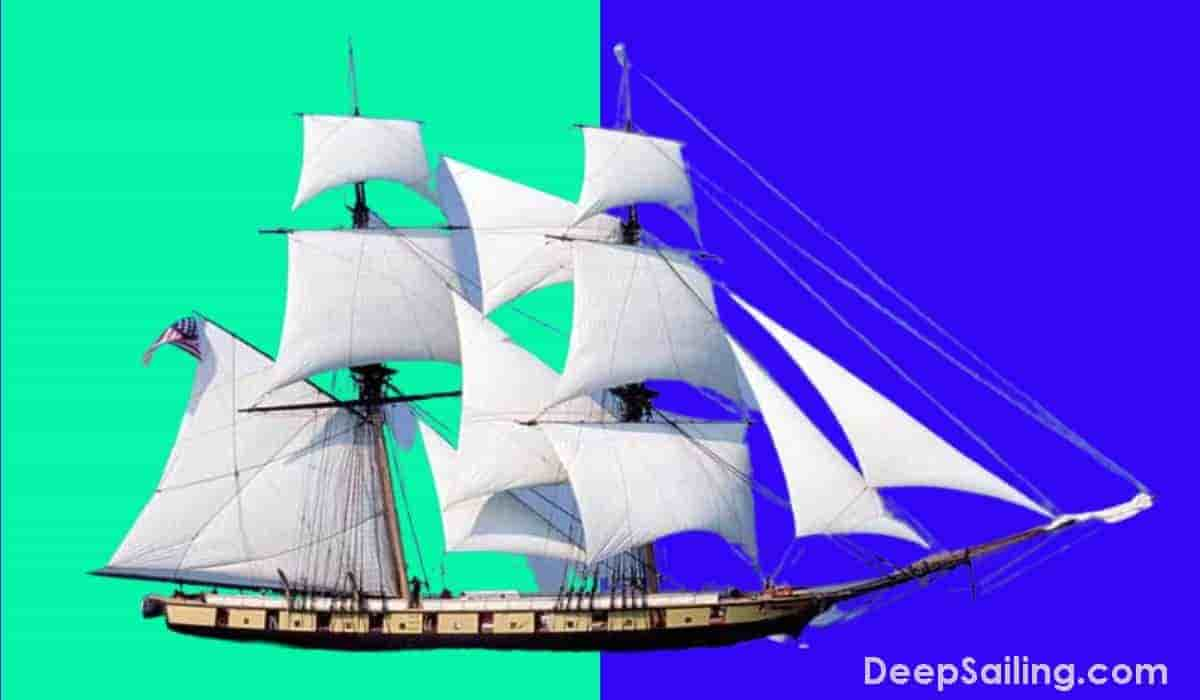
The brig is a two-masted sailing ship that was originally built in the 18th century with square rigging on both masts and sometimes had a spanker on the aft mast.
The length of a brig varied from 75ft to 165ft with tonnages up to 480 ith tonnages up to 480 and it needed a crew of 22 people ( 20 ).
The brig was used as a war vessel and a cargo ship for transporting goods and they were later used to ferry large cargo on the open seas since they could easily follow the direction of the prevailing winds.
It came with a berthing deck that had sleeping quarters for cabin crew and marine officials, storage areas, a sail bin, a wood-paneled stove room, guns, and carronades.
They would be brought into the harbor without using tugs and could maneuver well in small areas.
Famous brig ships are listed below.
- USS Argus : This was a United States Navy brig that fought in the First Barbary War, taking part in the blockage of Tripoli and the war of 1812
- USS Reprisal : This was the first ship of the United States Navy
- USS Somers : This was a brig in the United States Navy that became infamous for being the only US Navy ship to undergo a mutiny
14. The Ketch

A ketch is a two-masted sailboat that originated in the 17th century with most ketch ships ranging from 40ft to over 120ft in size and weighing between 100 and 250 tons. A ketch ship needed a smaller crew of only 4 people to operate ( 21 ).
The ketch looked just like the Yawl and as stated had two masts each having a fore-and-aft rig with the difference between the two being that the ketch had a mizzen mast placed on the taller mainmast but at a position in front of the rudder post. The mizzen in this case aided in maneuvering the vessel.
A ketch ship was used for:
- Cargo Transportation
15. The Hulk
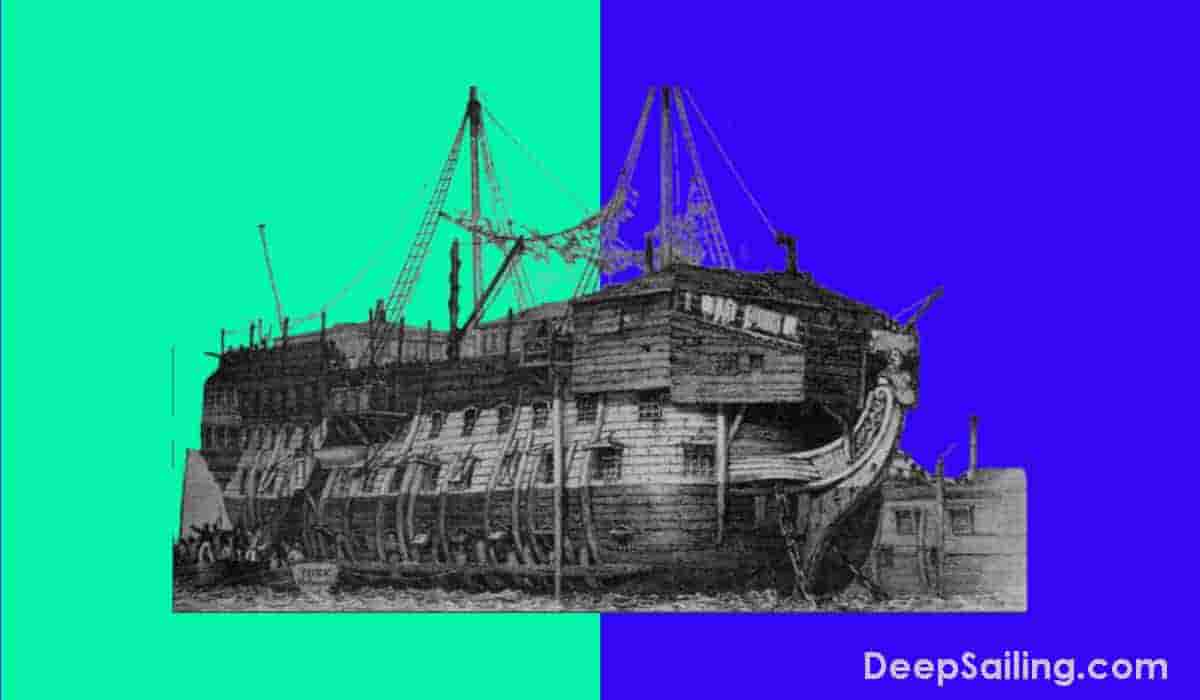
A hulk is an 18th-century ship that is a derivative of the Carrack with a weight of 400 tons that is afloat but incapable of going to sea. In maritime terms, the name "Hulk" was given to ships that were outdated, stripped down or unprofitable to run.
The bulk of the hulk fleet was comprised of abandoned ships, stripped down and therefore could not continue to ply across the Mediterranean Sea as cargo or transport ships.
They are stationary and kept for their buoyancy and were used as a prison, a place for gambling.
- Maritime Museum Of The Atlantic. " Sailing Ship Rigs ".
- The New York Times. " America's Cup Held Here Since 1851 ", PDF.
- World History Encyclopedia. " Carrack Definition ," Paragraph 3.
- Same As Reference 3
- Military History. " Carracks, Famous Carracks ," Paragraph 9.
- " Aken, tjalken en kraken " by Hans Haalmeijer & Dirk Adrianus Vuik, Page 12.
- Google Books Ngram Viewer. " Brigantine ".
- Gaspee Info. " Brigentines Described ," Paragraph 3.
- Wikipedia. " Barquentine ," Paragraph 1.
- " Ship: 5000 Years Of Maritime Adventure " by Brian Lavery, Page 137.
- Oxford English Dictionary (Online Edition). " Barque ".
- University of Houston. " No. 338 Clipper Ship ". Paragraph 2
- Marine Insights. " Windjammer Sailing Ships: From Past to Present ". Paragraph 8
- History Today. " Dutch Shipbuilding in the Golden Age ". Volume 34, No. 1
- " The Story Of The Sea, Volume 1 " by Arthur Quiller-Couch, Page 20.
- Whaling Museum. " Rigs Of Vessel, Ship ," Paragraph 1.
- " A Dictionary of Sea Terms " by Anstead, A, Page 96.
- Britannia. " Cutter, Sailing Craft ". Paragraph 1.
- " The Boats Of Men Of War " by William May & Simon Stephens
- Texas Navy Association. " Glossary Of Nautical Terms ". Page 1
- National Museum Of American History. " Ship Model, Ketch ". Paragraph 1

- Find A School
- Certifications
- North U Sail Trim
- Inside Sailing with Peter Isler
- Docking Made Easy
- Study Quizzes
- Bite-sized Lessons
- Fun Quizzes
- Sailing Challenge

What Type of Sailboat is This?
By: Zeke Quezada, ASA Equipment , Sailboats
While sailing in the Sir Francis Drake Channel in the British Virgin Islands I noticed a peculiar catamaran heading in our direction. A two-masted catamaran. Have you seen a boat like this? Does it have a name?
How often do you see a sailboat and realize that it has a different sail plan or configuration and most likely has a different name?
This guide to sailboats should help you identify the types of sailboats you might encounter while on your cruising adventures.
You’ll be able to find even more info on these different type of sailboats in our series “What’s in a Rig.”
What type of a boat is this…?

A sloop rig is a boat with a single mast and a fore and aft sail configuration. Sloops date back to the early 17th century but didn’t really become popular until the 20th century. The likely reason for their popularity is their ability to efficiently head upwind and how relatively simple they are to control – great for short-handing.
Cutter Rig:

A variation on the Sloop is the Cutter Rig. Although it has gone through some changes through the course of history, the modern cutter rig is generally a set-up with two headsails. The forward sail is called the Yankee, and the one slightly behind it is the staysail.

There are many who feel that this very old but very innovative sail plan is superior to the more popular and ubiquitous sloop rig and others. The junk is predicated upon fully battened sails, a characteristic associated with more modern racing vessels, and they typically lack any standing rigging (stays and shrouds). Due to the full batten set-up, the sails maintain an efficient, consistent shape and are fast, especially downwind. In a big breeze, junk owners will attest that they’re extremely easy to reef and, as an added bonus, are inherently self-tacking.

They are two masted rigs with a main mast and a (smaller) mizzenmast that is set in front of the rudder post – they carry a jib just like a sloop. Generally, ketches will be in the 40-plus foot range. The reasoning for this is that before sailing hardware was as advanced as it is now, designers were looking for ways to carry a good amount of sail but make it manageable at the same time. This configuration served that purpose and, while doing so, also gave sailors quite a few options for various weather conditions and situations.

Like, the ketch, a yawl is equipped with two masts, a main and a mizzen, but ordinarily, on a yawl, the mast is smaller and set behind the rudder post. While some yawl sailors contest the small sail configuration that hangs over the stern as an aid to heaving to and steadying life at a mooring, most concede the mizzen on a yawl is not what it is on a ketch. Typically, it doesn’t provide any horsepower to speak of or ease-of-handling benefits in splitting the rig like a ketch or schooner might.

A gaff rig employs a spar on the top of the sail, and typically other sails can be set in conjunction with that mainsail with the gaff. Often, on the smaller, non-tall ship, gaff rigs, there will be a small triangular sail that fits between the main and the mast like a puzzle piece – this is the topsail.
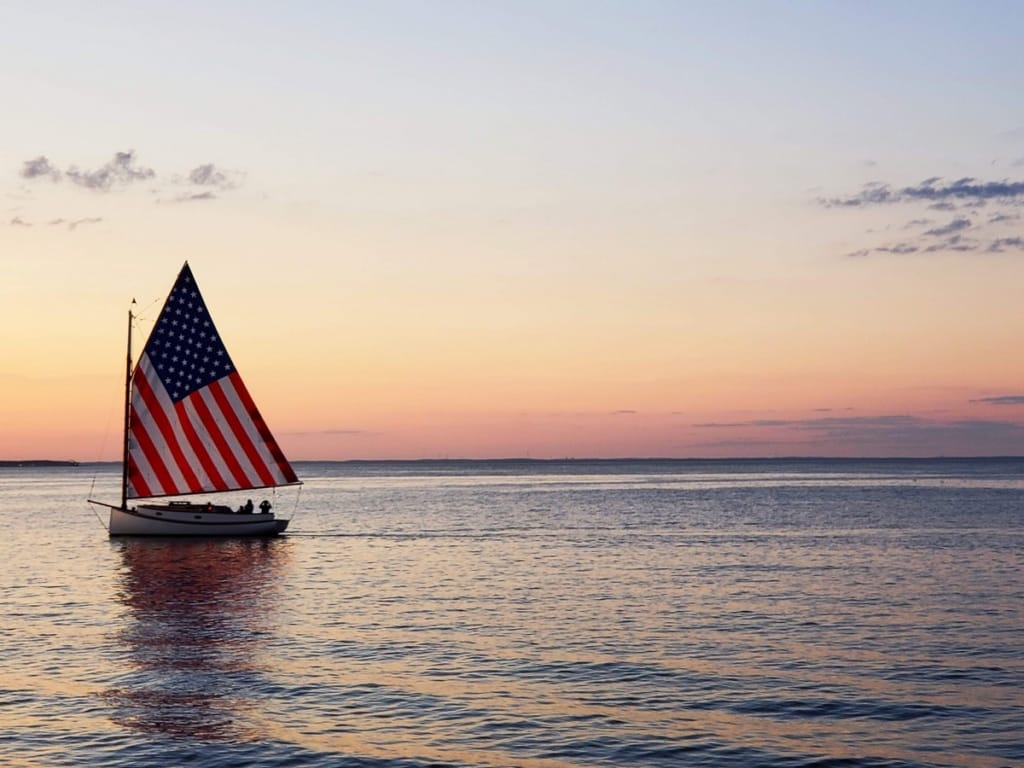
A cat rig is a single mast situated well forward, near the bow, which carries a large single sail and has no standing rigging, sometimes referred to as “unstayed.” An Optimist, Laser or Sabot are common (smaller) examples of a cat rig, but many bigger boats utilize the set-up.

A schooner is a sailboat with at least two masts, with the forward mast (foremast) being a bit shorter than the main mast. Although a schooner can have more than two masts, most were just two. During the time of their popularity, this smaller and better upwind setup allowed for a more efficient and manageable sailboat. It was the preferred choice of pirates, privateers, slaveship captains and others.
So what type of boat is this? Let us know. Find us on Social media and share your thoughts @AmericanSailing

Related Posts:

- Learn To Sail
- Mobile Apps
- Online Courses
- Upcoming Courses
- Sailor Resources
- ASA Log Book
- Bite Sized Lessons
- Knots Made Easy
- Catamaran Challenge
- Sailing Vacations
- Sailing Cruises
- Charter Resources
- International Proficiency Certificate
- Find A Charter
- All Articles
- Sailing Tips
- Sailing Terms
- Destinations
- Environmental
- Initiatives
- Instructor Resources
- Become An Instructor
- Become An ASA School
- Member / Instructor Login
- Affiliate Login
Woodwind II
After their charter operation with Woodwind proved a success the operators returned to Scarano Boat Building five years later for a second vessel, Woodwind II. Besides being a fast sailor, her greatest claim to fame is probably her appearance in the movie Wedding Crashers when father of the bride Christopher Walken takes her out for a sail.
LOA : 84 feet (26 meters) Type : two masted schooner Year launched : 1998 Certification : USCG certified for 49 passengers Current location : Woodwind II is operated on Chesapeake Bay with her sister ship Woodwind by Schooner Woodwind Cruises.
Contemplating a new build? A restoration? Tell us a bit about your project in the provided form or give us a call. We are anxious to hear about it.
194 SOUTH PORT RD. ALBANY, NY 12202-1075
Phone: 518-463-3401 Email: [email protected]
- Power Vessels
- Sailing Vessels
- Historic Replicas
- Repair & Restorations
- Canvas Shop
- Why Scarano
- Privacy Policy
© 2023 Scarano Boat Building Inc. All rights reserved.
- AI Generator
85 Two Masted Sailboat Stock Photos & High-Res Pictures
Browse 85 two masted sailboat photos and images available, or start a new search to explore more photos and images..
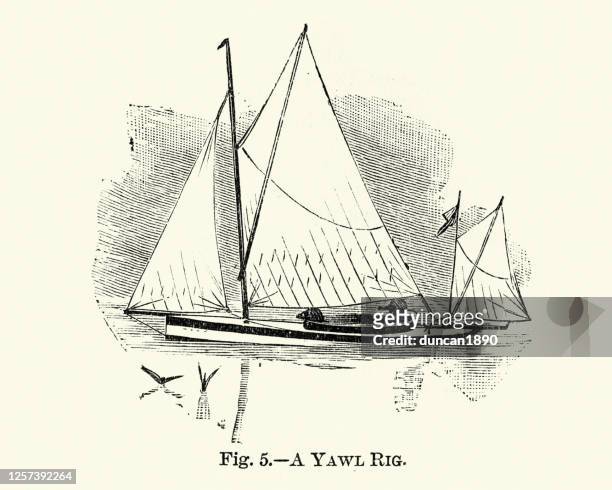
- Share full article
Advertisement
Supported by
Ahead of Olympics, World Anti-Doping Agency Faces a Trust Crisis
Concerns are growing that the body whose job is keeping sports free of illegal drugs is failing at that mission, leading Congress to question U.S. support.

By Michael S. Schmidt , Jenny Vrentas and Tariq Panja
Michael S. Schmidt reported from New York, Jenny Vrentas from Washington, and Tariq Panja from London.
Two months before the Olympics are scheduled to begin in Paris, the global agency tasked with policing doping in sports is facing a growing crisis as it fends off allegations it helped cover up the positive tests of elite Chinese swimmers who went on to compete — and win medals — at the last Summer Games.
The allegations are particularly vexing for the World Anti-Doping Agency, which has long billed itself as the gold standard in the worldwide movement for clean sports, because they raise the specter that the agency — and by extension the entire system set up to try to keep the Olympics clean — cannot be trusted.
Athletes are openly questioning whether WADA can be relied upon to do its core job of ensuring there will be a level playing field in Paris, where some of the same Chinese swimmers are favorites to win more medals.
And in recent days, pressure on WADA has increased significantly, particularly from the United States, which is one of the agency’s chief funders, and as new questions have emerged about WADA’s appointment of an independent prosecutor to investigate the allegations, and whether WADA has provided an accurate account to the public about the appointment, according to interviews and documents reviewed by The New York Times.
On Wednesday, the Biden administration’s top drug official — who is also a member of WADA’s executive committee — sent a stinging letter to the antidoping agency laying out how it needs to appoint a truly independent commission to investigate how the positive tests were handled and demanding that its executive board hold an emergency meeting within the next 10 days.
“Let me underscore the extreme concern I have been hearing directly from American athletes and their representatives on this issue,” the official, Dr. Rahul Gupta, wrote in the letter, which was sent on Biden administration letterhead. “As I have shared with you, the athletes have expressed they are heading into the Olympic and Paralympic Games with serious concerns about whether the playing field is level and the competition fair.”
That same day, the senator in charge of the subcommittee that provides funding to WADA, Chris Van Hollen, Democrat of Maryland, said, “We need answers before we support future funding.” (The United States contributes more to WADA’s budget — pledging more than $3.6 million this year — than any nation.)
Then on Friday, a congressional aide said that a bipartisan House committee investigating the Chinese Communist Party had begun looking into the positive tests.
Lilly King, a two-time Olympic gold-medalist and a member of U.S.A. Swimming’s Athletes’ Advisory Council, said that she no longer trusts that WADA is doing its job to keep athletes who violate antidoping rules out of the Games.
“I am not confident when I get up on the blocks that the people to my right and my left are clean,” Ms. King said in a telephone interview on Friday. “And that’s really unfortunate, because that’s not something I should have to focus on while racing at the Olympics.”
The mounting pressure and growing concerns about the credibility of Olympic competitions have been met with silence from the two groups that account for a major portion of the International Olympic Committee’s revenue: its chief broadcaster and sponsors.
NBC, whose broadcast rights payments comprise a significant portion of the I.O.C.’s total budget, did not respond to a question about whether it was confident it would be broadcasting an Olympics in which viewers could trust that the athletes they were watching would be clean.
The multimillion-dollar Olympic sponsors — Visa, Airbnb, Coca-Cola and Intel — did not respond to messages seeking comment on whether they were concerned about linking their brands with a Games in which athletes have expressed concerns about cheating. Allianz, a German financial services company, also declined to comment.
The Times reported last month that WADA failed to follow its own rules after 23 elite Chinese swimmers all tested positive for the same banned drug in 2021, months before the last Summer Olympics. The drug — trimetazidine, known as TMZ — is a prescription heart medication, but it is popular among athletes looking for an advantage because it helps them train harder, recover faster and quickly moves through the body, making it more difficult to detect.
Two days after the Times article was published, WADA’s president, Witold Banka, and other top officials from the agency held a news conference during which they said they had no choice but to accept the explanation provided by China’s antidoping agency for the positive tests. The Chinese agency claimed that all of the swimmers had inadvertently ingested the drug because they ate food from a kitchen contaminated by TMZ.
In the days that followed, WADA published a lengthy document that again tried to explain its decision.
But neither move satisfied athletes, sports officials and antidoping officials perplexed by WADA’s apparent unwillingness to pursue its own investigation of the positive tests. Within days of the news becoming public, however, WADA appointed a special prosecutor, Eric Cottier, to review its handling of the case.
That decision, too, quickly drew criticism.
Mr. Cottier is a former attorney general of Vaud, a Swiss region that has become the center of international sports, and that is home to several sports organizations, including the I.O.C. But interviews showed that Mr. Cottier had been nominated to lead the investigation by the official who was in charge of auditing the agency’s intelligence and investigations department at the time the Chinese swimmers tested positive.
The auditor, Jacques Antenen, served as Vaud’s police chief under Mr. Cottier when he was Vaud’s attorney general. In a telephone interview on May 3, Mr. Antenen said he had contacted Olivier Niggli, WADA’s most senior administrator, in the days after the disclosure of the positive tests to suggest that Mr. Cottier might be a good choice to lead the investigation.
“I didn’t recommend him; I just said if you need someone, it’s a good choice,” Mr. Antenen said. He said he did not know if others had been considered for the role.
Regardless of Mr. Cottier’s abilities and qualifications, his physical proximity to figures close to WADA, the I.O.C. and the sports movement are problematic, governance experts said.
Mr. Cottier and Christoph de Kepper, the I.O.C.’s director general, were among the people who celebrated Mr. Antenen’s retirement from the police force at a party in 2022. The I.O.C. contributes half of WADA’s annual $40 million budget.
The celebration, which was featured in the police service’s in-house magazine, was first reported by The Associated Press. A caption with a picture of two of the men in the magazine reads, “Attorney General Eric Cottier came to greet his old friend Jacques Antenen.”
A WADA spokesman, James Fitzgerald, said his agency had, in fact, contacted Mr. Antenen first, to ask “if he knew of someone with the requisite credentials, independence and availability to carry out a thorough review of WADA’s handling on this case.”
“These attempts to slur the integrity of a highly regarded professional just as he begins his work are getting more and more ridiculous and are designed to undermine the process,” Mr. Fitzgerald said.
There are also new questions about WADA’s public statements related to the appointment of Mr. Cottier. In a statement to The Times, WADA said it had discussed Mr. Cottier’s appointment with its board before formally appointing him to the role.
But Dr. Gupta’s Office of National Drug Control Policy said in a statement that shortly before the formal announcement of Mr. Cottier’s hiring in April, WADA told its board an investigator had already been chosen.
Dr. Gupta said in his letter to WADA that he was “deeply concerned” that the executive committee “was not adequately briefed with essential information throughout this process.”
Current and former athletes are now asking for more testing worldwide heading into the Paris Games, but they acknowledged that their concerns about the global antidoping regulator are unlikely to be allayed in time for the opening ceremony.
Ms. King, the American swimmer, said that when she learned of the undisclosed positive tests, she felt as if this were a replay of her experience from the 2016 Rio Olympics , when she won a gold medal in the 100-meter breaststroke over a Russian swimmer, Yulia Efimova, who had failed a drug test earlier that year but was allowed to compete after the result was overturned on appeal.
Katie Meili, an athlete representative on U.S.A. Swimming’s board of directors and the bronze medalist in that race behind Ms. King and Ms. Efimova, said athletes had “put a ton of faith in WADA.”
“Yes, the positive tests are a concern, and that’s a bad thing,” she said. “But even more concerning to me is that the international regulator is not doing their job.”
Amy Chang Chien contributed research.
Michael S. Schmidt is an investigative reporter for The Times covering Washington. His work focuses on tracking and explaining high-profile federal investigations. More about Michael S. Schmidt
Jenny Vrentas is a Times reporter covering money, power and influence in sports. More about Jenny Vrentas
Tariq Panja is a global sports correspondent, focusing on stories where money, geopolitics and crime intersect with the sports world. More about Tariq Panja

IMAGES
VIDEO
COMMENTS
Learn the differences and features of four common types of two-mast sailboats: yawl, ketch, schooner, and brig. Find out how the location and size of the masts affect the sailing performance and balance of these boats.
Learn the names and features of five common types of two-masted sailboats: ketch, schooner, yawl, brig, and brigantine. Find out how to recognize them by their sail design, rigging configuration, and performance.
Learn about different types of sailboats with two masts, such as ketch, yawl, and brigantine, and see pictures and prices of used models. Find out the benefits and drawbacks of buying a used boat with two masts and how to choose the best one for your needs.
Learn about the different types of two-masted sailing boats, their origins, features and advantages. Compare schooners, yawls, ketches and brigantines and find out what makes them attractive and graceful vessels.
Learn the difference between fore-and-aft and square-rigged sails, and how to recognize the most common sail rig types. Find out what a two-masted ship with a square-rigged mainsail is called and see examples of other rigs.
Learn about the evolution and diversity of two-masted sailboats, from ancient origins to modern performance. Discover the features, types, and benefits of these vessels, as well as some famous examples and maintenance tips.
2. Yawl. A yawl is one of the typical two-masted sailing boats. It has two masts: a mizzen mast and the main mast. The mizzen mast is usually much shorter than the main mast. So, it is a leaning sailboat where the main mast is in the front part of the boat while the mizzen mast is in the back part.
As a rig, a yawl is a two masted, fore and aft rigged sailing vessel with the mizzen mast positioned abaft (behind) the rudder stock, or in some instances, very close to the rudder stock. This is different from a ketch, where the mizzen mast is forward of the rudder stock. The sail area of the mizzen on a yawl is consequentially proportionately ...
A ketch is a specific type of sailing rig characterized by the arrangement and size of the masts and sails. These are two-masted vessels that include a mizzenmast and a larger main mast, with a sloop-like jib. Ketches are typically over 40 feet in length, simply due to a need for significant power in a manageable size.
Learn about different types of two-masted sailboats, such as ketch, yawl, schooner, brig and brigantine, and their features and benefits. See examples of two-masted ships with square rigged sails and fore-and-aft sails.
A ketch is a two-masted sailboat with a tall mizzenmast mast aft of the mainmast. A key characteristic of Ketch sailboats is that their mizzenmast is shorter than the mainmast. The mainmast itself is typical and resembles a sloop mast. A ketch has a mainsail and one or more headsails on the mainmast, along with a single mizzen on the mizzenmast ...
Learn about the different types of sailboats with two masts, such as ketch, yawl and schooner, and how they compare to sailboats with one mast. Find out the pros and cons of having more sails, better sail area division and greater sail balance.
Here's an example of a two-masted naval cutter with an extra gaff mainsail and top gaff: Cutter Eems No. 1 (Delfzijl) Sailing Hydrofoil Sailing Hydrofoil at the America's Cup by Robert Couse-Baker. The Hydrofoil is a pretty new sailboat design. It's a racing sailboat with thin wing foils under the hull.
Orianda, a staysail schooner, with Bermuda mainsail. A schooner ( / ˈskuːnər / SKOO-nər) [1] is a type of sailing vessel defined by its rig: fore-and-aft rigged on all of two or more masts and, in the case of a two-masted schooner, the foremast generally being shorter than the mainmast. A common variant, the topsail schooner also has a ...
A brigantine is a two-masted sailing vessel with a fully square-rigged foremast and at least two sails on the main mast: a square topsail and a gaff sail mainsail (behind the mast). The main mast is the second and taller of the two masts. Older usages are looser; in addition to the rigorous definition above (attested from 1695 [citation needed]), the Oxford English Dictionary includes two c ...
Schooner sailing vessels for sale on YachtWorld are listed for a variety of prices from $12,359 on the relatively lower-priced, classic models all the way up to $12,102,585 for the exclusive custom-built yachts. Find Schooner boats for sale in your area & across the world on YachtWorld. Offering the best selection of boats to choose from.
Ketch: A two-masted sailboat with a smaller mizzen mast aft of the main mast; In summary, historical and special sailboats encompass a wide range of vessel types, from large, multi-masted tall ships to smaller, single-masted gaffers and classic sailboats.
The brig is a two-masted sailing ship that was originally built in the 18th century with square rigging on both masts and sometimes had a spanker on the aft mast. The length of a brig varied from 75ft to 165ft with tonnages up to 480 ith tonnages up to 480 and it needed a crew of 22 people .
Schooner: A schooner is a sailboat with at least two masts, with the forward mast (foremast) being a bit shorter than the main mast. Although a schooner can have more than two masts, most were just two. During the time of their popularity, this smaller and better upwind setup allowed for a more efficient and manageable sailboat.
Swan 65 ketch flying a spinnaker Fisher30 motorsailer ketch. A ketch is a two-masted sailboat whose mainmast is taller than the mizzen mast (or aft-mast), and whose mizzen mast is stepped forward of the rudder post.The mizzen mast stepped forward of the rudder post is what distinguishes the ketch from a yawl, which has its mizzen mast stepped aft of its rudder post.
Besides being a fast sailor, her greatest claim to fame is probably her appearance in the movie Wedding Crashers when father of the bride Christopher Walken takes her out for a sail. LOA : 84 feet (26 meters) Type : two masted schooner. Year launched: 1998. Certification : USCG certified for 49 passengers.
The Crossword Solver found 30 answers to "two masted sailboat", 4 letters crossword clue. The Crossword Solver finds answers to classic crosswords and cryptic crossword puzzles. Enter the length or pattern for better results. Click the answer to find similar crossword clues . Enter a Crossword Clue.
FRANCE-SAILING-RUSSIA-SEDOV-3. Browse Getty Images' premium collection of high-quality, authentic Two Masted Sailboat stock photos, royalty-free images, and pictures. Two Masted Sailboat stock photos are available in a variety of sizes and formats to fit your needs.
The Olympic flame arriving aboard a three-masted sailing ship in Marseille, France, on Wednesday. The Paris Games are scheduled to open on July 26.